






The Namibia Tourism Board (NTB) Europe office has been instrumental in promoting Namibia as a premier travel destination in Europe and the UK for over two decades. Through strategic marketing initiatives and a deep understanding of Namibia’s unique appeal, the Europe team plays a pivotal role in driving tourism to this remarkable country.
Focusing on the core values of sustainable tourism, the preservation of Namibia’s natural beauty, and the celebration of its rich cultural heritage, the Europe office works tirelessly to raise awareness about what makes Namibia truly special. Whether it’s the majestic landscapes, diverse wildlife, or the welcoming spirit of the Namibian people, the NTB Europe office ensures that travellers have the opportunity to discover the heart of Africa in a way that supports both the environment and local communities.
By promoting Namibia’s distinct charm, the Europe office helps to position the country as a top destination for those seeking adventure, authenticity, and unforgettable experiences. Their dedication to showcasing Namibia’s many treasures continues to play a vital role in the country’s tourism success, making it a must-visit location for travellers from Europe and beyond.
Namibia Head Office:
Sam Nujoma Drive Private Bag 13244
Windhoek
Namibia
Tel: +264 61 290 6000
Fax: +264 61 254 848 info@namibiatourism.com.na





To promote tourism in collaboration with our stakeholders with the view to encouraging persons to travel to and within Namibia. MISSION
To become a preferred tourist destination in the world by 2029.
Europe Office: Kaiserstr. 77 60329 Frankfurt
Germany
Tel: +49 69 770 673 092 info@namibia-tourism.com
Shanghai Office:
Shanghai Oriental Gateway Consulting Co.Ltd.
A405, Lane300, Panyu Road, Changning District, Shanghai.
Tel: (+8621) 6280 1700 Fax:(+8621) 6280 1700

is published by Venture Media in Windhoek, Namibia www.travelnewsnamibia.com
Tel: +264 61 383 450, 5 Conradie Street, Windhoek PO Box 21593, Windhoek, Namibia
EDITOR Elzanne McCulloch elzanne@venture.com.na
PRODUCTION MANAGER Liza Lottering liza@venture.com.na
PUBLIC RELATIONS Elzanne McCulloch elzanne@venture.com.na
LAYOUT & DESIGN Richmond Ackah Jnr. design@venture.com.na
CUSTOMER SERVICE Bonn Nortjé bonn@venture.com.na
TEXT CONTRIBUTORS
Elzanne McCulloch, Kirsty Watermeyer PHOTOGRAPHERS
Le Roux van Schalkwyk
Elzanne McCulloch
Charene Labuschagne
Eric van Zyl
Will Burrard-Lucas
Olwen Evans
If uncredited, images are stock or supplied.
Kirsty Watermeyer
Duncan Irvine
Piet van Rooyen
Suné van Wyk




Travel Namibia is published quarterly, distributed worldwide via Zinio digital newsstand and in physical format in southern Africa. The editorial content of TN is contributed by the Venture Media team, freelance writers and journalists. It is the sole property of the publisher and no part of the magazine may be reproduced without written permission from the publisher.
All information and travel details are correct at the time of going to press. This may have changed after the date of publication. Please check businesses' individual websites for up-to-date details. To advertise in Travel Namibia or any of our other publications, contact Elzanne:
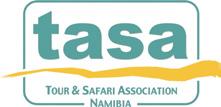






SURFACE AREA: Windhoek CAPITAL:
824,268 km²
INDEPENDENCE:
21 March 1990
CURRENT PRESIDENT:
Netumbo Nandi-Ndaitwah
Multiparty parliament
Democratic constitution Division of power between executive, legislature and judiciary
Secular state
Christian freedom of religion
90%

ROADS:
NATURE RESERVES: of surface area
HIGHEST MOUNTAIN: Brandberg
Spitzkoppe, Moltkeblick, Gamsberg
MAIN PRIVATE SECTORS: Mining, Manufacturing, Fishing and Agriculture 46%
BIGGEST EMPLOYER: Agriculture
FASTEST-GROWING SECTOR: Information Communication Industry
Diamonds, uranium, copper, lead, zinc, magnesium, cadmium, arsenic, pyrites, silver, gold, lithium minerals, dimension stones (granite, marble, blue sodalite) and many semiprecious stones
CURRENCY:
MATTERS TAX AND CUSTOMS
Foreign currency, international Visa, MasterCard, American Express and Diners Club credit cards are accepted.
EPHEMERAL RIVERS: Numerous, including Fish, Kuiseb, Swakop and Ugab 20% 14 400 680
OTHER PROMINENT MOUNTAINS: vegetation zones species of trees ENDEMIC plant species 120+ species of lichen
PERENNIAL RIVERS: Orange, Kunene, Okavango, Zambezi and Kwando/Linyanti/Chobe
HARBOURS: Walvis Bay, Lüderitz
MAIN AIRPORTS: Hosea
Kutako International Airport, Eros Airport
RAIL NETWORK:
6.2 telephone lines per 100 inhabitants
MOBILE COMMUNICATION SYSTEM:
Direct-dialling facilities to 221 countries
GSM agreements with 150 countries
LIVING FOSSIL PLANT: Welwitschia mirabilis
BIG GAME:
Elephant, lion, rhino, buffalo, cheetah, leopard, giraffe
20 antelope species
250 mammal species (14 endemic)
256 699
50 reptile species
ENDEMIC BIRDS including Herero Chat, Rockrunner, Damara Tern, Monteiro’s Hornbill and Dune Lark frog species 15%
All goods and services are priced to include value-added tax of 15%. Visitors may reclaim VAT.
ENQUIRIES: Namibia Revenue Agency (NamRA) Tel (+264) 61 209 2259 in Windhoek
Public transport is NOT available to all tourist destinations in Namibia.
There are bus services from Windhoek to Swakopmund as well as Cape Town/Johannesburg/Vic Falls. Namibia’s main railway line runs from the South African border, connecting Windhoek to Swakopmund in the west and Tsumeb in the north.
There is an extensive network of international and regional flights from Windhoek and domestic charters to all destinations.
Most tap water is purified and safe to drink.
Visitors should exercise caution in rural areas.
GMT + 2 hours
0.4182 medical doctor per 1,000 people privately run hospitals in Windhoek with intensive-care units
4
Medical practitioners (world standard) 24-hour medical emergency services
3.1 million DENSITY: 3.8 per km²
461 000 inhabitants in Windhoek (15% of total)
EDUCATIONAL INSTITUTIONS: over 1,900 schools, various vocational and tertiary institutions bird species FOREIGN REPRESENTATION
220 volts AC, 50hz, with outlets for round three-pin type plugs
More than 50 countries have Namibian consular or embassy representation in Windhoek.

Dear esteemed partners and readers,
It is with great pride that we at the Namibia Tourism Board share our excitement for the continued growth and development of tourism in our remarkable country. Namibia, with its vast landscapes, rich cultural heritage, and wildlife treasures, is increasingly becoming a must-visit destination for travellers who seek not only adventure but also the authentic beauty of a land that honours its people, wildlife, and environment.
Namibia is a land of contrasts: from the iconic red dunes of the Namib Desert to the magnificent Fish River Canyon, the sweeping savannas, and the vibrant energy of our cities, it offers a diverse range of experiences for the discerning traveller. Whether it’s the raw adventure of safari, the peaceful serenity of the desert, or the opportunity to engage with our welcoming communities, Namibia presents something for everyone, inviting travellers to immerse themselves in a land as beautiful as it is captivating.
This year, this special publication once again focuses on conscious tourism – a theme that resonates deeply with Namibia’s values and the NTB’s mission. Conscious tourism is more than just a trend; it is a commitment to sustainability, community development, and responsible travel. In a world increasingly concerned with the environmental and social impacts of tourism, Namibia stands as a beacon of mindful travel. We are focused on preserving our pristine natural resources while ensuring that the benefits of tourism reach local communities, empowering them to thrive while conserving the land they cherish. This approach is part of the broader vision outlined by the NTB, which prioritises both the growth of our tourism industry and the protection of our environment for future generations.
Tourism matters because it is a powerful driver of economic growth, creating jobs and supporting local businesses nationwide. From the bustling markets in Windhoek to the
remote lodges in the Kaokoland, tourism creates opportunities for countless Namibians. It fosters cross-cultural exchanges and builds global awareness of the importance of conservation, which is central to our identity as a country. Sustainable tourism practices in Namibia help safeguard our iconic wildlife. Our commitment to the Kavango Zambezi Transfrontier Conservation Area (KAZA TFCA) exemplifies how regional cooperation can create vast, protected ecosystems that benefit both nature and people.
The NTB has ambitious goals as we look towards the future. This includes enhancing our marketing efforts to connect with new international markets and strengthen existing partnerships. We will continue to promote our diverse tourism offerings through exhibitions, roadshows, and strategic collaborations. We also aim to improve our tourism infrastructure, ensuring that our services meet global standards of excellence while preserving the essence of what makes Namibia unique.
We invite you to explore the beauty of Namibia, embrace its sustainability-focused tourism initiatives, and share in our commitment to creating a positive impact for both travellers and locals alike. We look forward to welcoming the world to Namibia, where every journey contributes to the preservation of our lands, cultures, and communities.
Thank you for supporting Namibia as a premier travel destination.
Heartfelt greetings,
Namibia Tourism Board

By putting nature first at Ongava, we set the scene for a renewed understanding and appreciation of the importance of wildlife conservation.
There’s a moment, standing on the edge of Hartmann’s Valley in Namibia’s northwest, when the sheer scale of the landscape takes your breath away. The horizon stretches endlessly, a vast and untouched wilderness where the rhythm of nature remains unbroken. Further south, in Etosha and the neighbouring private reserves such as Ongava, the same feeling takes hold. Wild spaces where rhinos, elephants, lions roam, unencumbered by the world beyond or the relentless march of industry.
Namibia is a country rich in resources. Mining and agriculture have shaped its economy and continue to play a vital role. But these industries are not always compatible with the preservation of wilderness. What tourism offers is a different path – one that values nature as it is, not as something to be extracted or altered. Tourism sustains not only the landscapes but also the communities that have lived alongside wildlife for generations, weaving conservation and culture into an economy that respects and preserves.
This is why tourism matters. For a country like Namibia, it is a sustainable, purposedriven industry that thrives on what makes this place special: the raw beauty of untouched nature, the connection between people and the land, and the adventures that immerse travellers in something bigger than themselves. Conscious tourism – done right – doesn’t take. It gives back. It supports conservation, uplifts communities, and ensures that all we leave behind are footprints.
This year, as we showcase Namibia to the world, we embrace this message: to travel here is to celebrate, not consume. It is to experience Namibia’s wild soul while ensuring that future generations will do the same. We invite visitors to be part of this story – to see, to appreciate, and to protect. Because when done right, tourism is not just an industry. It is a promise – to keep Namibia wild, free, and thriving.
We hope you enjoy the inspiring stories this annual special edition of Travel Namibia showcases. Learn about Namibia’s tremendous successes in conservation and black rhino population growth. Landscape-level conservation and rehabilitation efforts that dedicate space to the wilderness. Tourism products that approach conscious tourism in a wonderfully wholistic way, dedicated to sustainable ways of sharing our incredible country. Adventures that give more than they take. We hope you fall in love with Namibia and share in our passion for this wild and wonderful, untamed and unencumbered land.
With love from Namibia,

Elzanne McCulloch Editor

Cover image: Olwen Evans for Ongava @olwenevansphotography


Etosha National Park Southern Namibia

pg. 28 pg. 8
Zambezi Region pg. 54

P8 DISCOVER ETOSHA NATIONAL PARK
P16 Restoring the Rhino Kingdom at Ongava Game Reserve
P24 Serene and wide-open at Etosha Heights

P28 DISCOVER SOUTHERN NAMIBIA
P38 The desert Symphony at Wilderness Kulula Desert Lodge
P44 The sound of Silence in the NamibRand
P48 A whale of a day at Walvis Bay

P54 DISCOVER THE ZAMBEZI REGION
P60 Eyes of the wild at AfriCat Foundation

P64 DISCOVER THE SKELETON COAST & KUNENE REGION
P70 A castle of love and legends at Hotel Heinitzburg
P75 New Visa Regulations coming to Namibia What you need to know


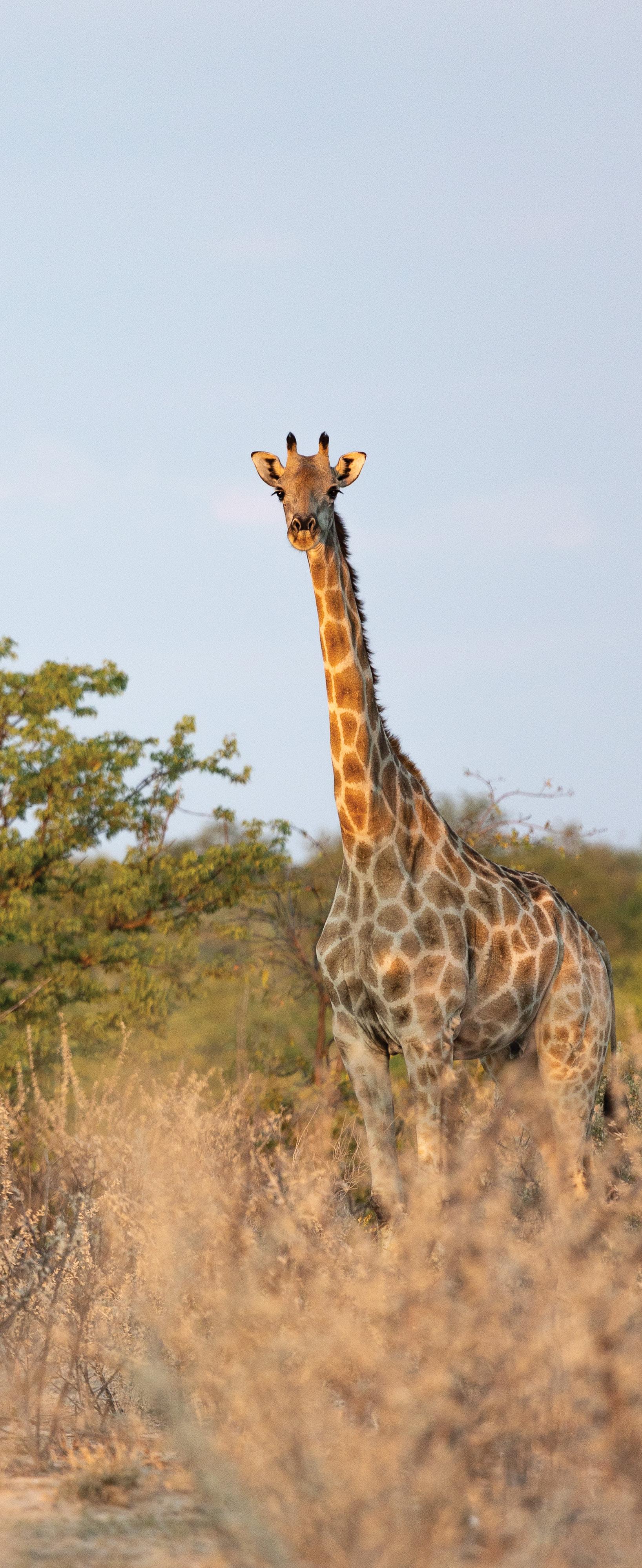
A region of unrivalled wildlife, timeless landscapes and unforgettable adventure
By Elzanne McCulloch
In the hushed quiet of the afternoon, I found myself at a waterhole, the air alive with the sounds of nature. A soft breeze swirled white dust into the air, the particles dancing in the sunlight, the landscape all around barren and forlorn, yet the stretch of white pan before me is the epicentre of a prolific national park. A distant rumble of thunder hinted at rain, but for now, the drama unfolded under the expanse of an endless sky. Zebras and springbok mingled cautiously at the water’s edge, their every movement a study in grace. Then, like a scene from a dream, an elephant emerged on the horizon, its silhouette majestic against the golden light. Time seemed to stand still as it approached, each step resonating with the weight of centuries.
This is Etosha, a place where the wild reveals its rhythm, and the soul of Africa is laid bare. From its shimmering salt pan – so vast that it is visible from space – to its vibrant ecosystems teeming with life, Etosha is Namibia’s crown jewel. It is a sanctuary of contrasts, where the stark beauty of the landscape meets the vibrancy of its wildlife.
Etosha is a portal to the wild heart of Namibia, inviting you to witness life in its raw, unfiltered splendour.


The Etosha Pan is the park’s defining feature – a vast, ancient lakebed that transforms with the seasons. During the dry months, the shimmering salt flats stretch endlessly, creating a surreal, lunar-like landscape. When the rains arrive, the pan comes alive, attracting flamingos and other migratory birds in their thousands. The interplay of light, water and life is a photographer’s dream and a reminder of nature’s incredible adaptability.
Etosha’s extensive network of roads allows for thrilling selfdrive safaris. With over 114 mammal species and 340 bird species, every turn promises a new encounter, from majestic elephants to elusive cheetahs. Guided game drives provide expert insights into the park’s flora and fauna, ensuring a deeper appreciation of its wonders.
For photographers, Etosha is paradise. The stark beauty of the salt pan, the vibrant hues of sunsets and the dynamic interplay of wildlife offer endless opportunities for stunning shots. Early mornings and late afternoons are prime times to capture the magic of the bush.
Etosha’s varied habitats make it a haven for bird lovers. From the striking Lilac-breasted Roller to the regal Kori Bustard, the park is a canvas of avian diversity. The summer months, when migratory species arrive, are particularly rewarding.

Etosha National Park transforms with the seasons, offering a unique charm year-round. In the dry season (May to October), wildlife congregates around waterholes, creating unparalleled opportunities for game viewing and photography. The sparse vegetation and clear skies enhance visibility, making it easier to spot iconic species. During the rainy season (November to April), the park comes alive with vibrant greenery, dramatic thunderstorms and the arrival of migratory birds. This is also the calving season, when young animals abound, and the Etosha Pan often fills with water, attracting flocks of flamingos and pelicans. Whether you visit during the parched stillness of the dry months or the lush vitality of the rains, Etosha’s ever-changing landscape ensures it remains captivating in every season.


OKAUKUEJO WATERHOLE: A STAGE SET FOR DRAMA
Okaukuejo is one of Etosha’s most popular camps, known for its floodlit waterhole. Here, visitors can witness nocturnal wildlife gatherings, from lions on the prowl to elusive leopards quenching their thirst. Sightings of rhinos and elephants are almost guaranteed. The waterhole is a magnet for animals, offering a front-row seat to the circle of life.

Etosha National Park is home to a wide variety of wildlife, but some species are particularly rare and special to spot
African Wildcat (Felis lybica) – The ancestor of the domestic cat, this small feline is incredibly elusive and well-camouflaged. It is mostly active at night and is sometimes seen darting across roads or near waterholes in the evenings.
Pangolin (Smutsia temminckii) – One of the most sought-after and rarely seen mammals in Africa, the ground pangolin is highly nocturnal and incredibly shy. Lucky visitors may catch a glimpse of one shuffling through the bush on a night drive.
Honey Badger (Mellivora capensis) – Although they are tough and fearless, honey badgers are not frequently spotted in Etosha. These nocturnal animals are known for their ferocity and intelligence, and sightings are often reported at waterholes at night.


Explore 34,000 hectares of authentic wilderness on the eastern boundary of Etosha National Park where conservation and tourism go hand in hand to provide you with a unique and unforgettable experience.
LAUNCH OFFER: New Onguma Trails Camp offers 2 night walking trails from N$ 26,000 per person fully inclusive (April to Sept), plus the option to extend to 3 nights.
• Book 3 or more nights at one of Onguma’s five lodges & get a free bush breakfast when booking a walk.
• Book Camp Kala for 4 nights and get a fifth night free, either at the camp or on the Dream Cruiser. T&C’s and usual trade commissions apply.


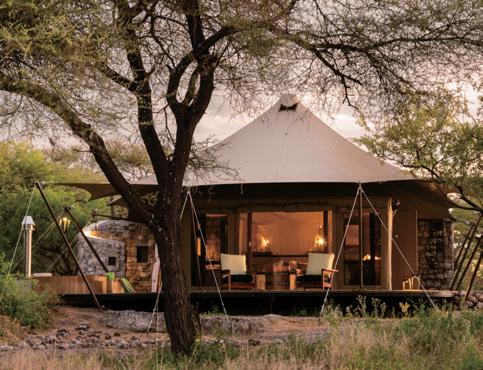




Etosha is a realm of wild wonder, where the wilderness meets timeless landscapes. A haven for Namibia’s most iconic species, the park’s reputation for being one of the most popular national parks in Africa is well-deserved. Take your time and explore well. Visit the myriad of waterholes and spend leisurely hours waiting for and watching the park’s wild denizens in their natural habitat. Whether you are seeking close encounters with Namibia’s iconic wildlife, the serenity of its open plains or the thrill of discovery, Etosha delivers an experience that lingers in the heart long after the journey ends.
Let Etosha National Park take you on a journey into the wild.





To ensure the safety of both visitors and wildlife, as well as to preserve the pristine environment of Etosha National Park, all guests are required to adhere to the following rules:
• Stay in your vehicle: Do not leave your vehicle except at designated rest stops, camps or viewpoints.
• Observe speed limits: The speed limit within the park is 60 km/h. Drive carefully to avoid disturbing wildlife.
• No feeding of wildlife: Feeding animals disrupts their natural behaviour and can make them reliant on human food.
• Respect park hours: Entry and exit are only allowed during designated times (from sunrise to sunset), and nighttime driving is prohibited.
• Dispose of waste responsibly: Use the bins provided to keep the park clean and protect its ecosystems. Plastic bags are prohibited in Etosha.
• Stay on the roads: Off-road driving is strictly prohibited to prevent damage to the fragile environment.
• No drones allowed: The use of drones is strictly prohibited in all national parks in Namibia.
By following these rules, you contribute to the preservation of this incredible wilderness for generations to come.


Text Kirsty Watermeyer
Since its inception in 1993, the Black Rhino Custodianship Programme has positioned Namibia as a global leader in black rhino conservation. The custodians – dedicated individuals who care for these majestic creatures – are the unsung heroes behind this remarkable success story. Their unwavering commitment and resilience not only provide hope for the future of black rhinos but also play a crucial role in safeguarding our planet’s rich biodiversity. This programme is a powerful reminder that, even in the face of daunting challenges, we have the capacity to make a lasting, positive impact on the world around us.
As the Black Rhino Custodianship Programme manager at the Ministry of Environment, Forestry and Tourism, Birgit Kötting has witnessed the incredible transformation of Namibia’s black rhino population firsthand. This journey began in the aftermath of near extinction due to poaching in the late 20th century. Today, Namibia’s vision is to re-establish viable, healthy breeding populations of Diceros bicornis throughout its former range by 2030.


“Namibia lost nearly all of its black rhinos during the late ’60s and early ’70s,” Birgit explains. “At that time, only a few remained on farmland and in small pockets in the Kunene Region.” In response, the government took action, relocating the surviving rhinos to Etosha National Park, where they began to thrive. “Etosha became a sanctuary for black rhinos, and from there, we were able to reintroduce them to other parks,” she adds.
However, simply relocating rhinos to parks was not enough for long-term success. Recognising the need for a more sustainable approach, the ministry established the Black Rhino Custodianship Programme in 1993. This innovative initiative allowed private landowners to care for these magnificent creatures on their land, while the rhinos remained the property of the government.
The programme has since expanded to include 30 freehold properties and 13 communal custodians, contributing to a significant increase in Namibia’s black rhino population.
One of the first custodians in the programme was Ongava Game Reserve. Meaning “rhino” in the Herero language, Ongava has become a sanctuary where these large mammals can thrive in their natural habitat. “Ongava has implemented top-tier antipoaching measures and monitoring systems, which are crucial
for effective conservation,” Birgit explains. “Good monitoring is the foundation of anti-poaching. If you know what you have and where they are, you can protect them more effectively.”
Birgit adds, “Ongava is one of our greatest success stories.” Their dedication has led to significant population growth, creating the need for land expansion to accommodate the thriving rhino community. The reserve’s success has brought about a new challenge: space for its growing rhino population. As a result, Ongava is now undergoing expansion. Thankfully, its visionary owners prioritise rhino conservation, choosing to expand the reserve’s territory over pursuing profit.
The Black Rhino Custodianship Programme has relocated breeding populations of black rhinos to suitable habitats, establishing free-ranging populations. This initiative relies on landholders who are both willing and able to take on the responsibility of providing care and security for the rhinos. Custodians are tasked with monitoring the rhinos, ensuring they have access to food and water, and safeguarding them to the best of their ability.
The success of the Black Rhino Custodianship Programme is evident in its impressive growth rate. Since its inception in 1993, the programme has seen the black rhino population grow from just 11 translocated individuals to around 750 today.
Affordable and convenient circuit flights, designed for travellers who want to spend more on unforgettable experiences and less on transport. Enjoy a seamless journey to Namibia’s top tourism hotspots with flexible route options, no hidden costs, and a focus on comfort and safety.










Ongava is a sanctuary where the spirit of conservation meets the majesty of the wild. As one of the largest rhino custodianships in Namibia, it plays a vital role in safeguarding these iconic creatures. It is also one of the few private game reserves in southern Africa where guests can witness both black and white rhinos in their natural habitat – a rare privilege that few will ever experience.
With four exquisite lodges nestled within the reserve, Ongava offers a truly intimate experience. It welcomes a limited number of guests to ensure peace and exclusivity. Each lodge is a masterpiece in itself, seamlessly blending luxury with nature. They evoke the timeless essence of the bush while offering modern comforts. The architecture mirrors the harmony between ageold traditions and contemporary design, creating an atmosphere of quiet elegance and deep respect for the land.
This remarkable increase highlights the programme’s global significance, especially in the face of escalating poaching threats. As Birgit puts it, “The custodianship programme boasts the best growth rate for black rhinos in the world.”
Reflecting on her journey, Birgit expresses the profound joy of working with these incredible animals. “They’re intelligent and surprisingly trusting,” she says, recalling moments spent with them in the field. Birgit shares many anecdotes about the unique personalities of each rhino, noting how, after spending time with them in a boma setting before translocation, she learned that rhinos can recognise you by the sound of your voice. She also observed that female rhinos tend to be more independent, while the males are often more affectionate.
In a world often filled with disheartening news, it is inspiring to witness places like Ongava Game Reserve, where dedicated individuals are creating a conservation success story that will resonate for generations. It serves as a powerful reminder that, even in the face of daunting challenges, we have the power to make a positive impact. This great journey is one where a vision was transformed into a reality, and it is truly a story worth celebrating. TN
For more information on Ongava Game Reserve and its lodges, visit: www.ongava.com





14. Sun Karros Daan Viljoen
15. Sossus Dune Lodge
16. Sesriem Campsite
17. Naukluft Camp
18. Hardap Resort
19. Duwisib Castle
20. Shark Island Resort
21. Fish River Canyon & Hobas Camp
22. /Ai-/Ais Hotsprings Spa
23. Mile 72 24. Mile 108
25. Jakkalsputz








Photographs

Elephants playfully rolling in the mud on a scorching summer day – a huge herd, with several young ones of various ages. It is a sight of pure joy. I could watch them for hours, captivated by their carefree antics as they fling mud over their backs, the youngest sliding on its belly in the cool, soft earth, and the eager excitement palpable as they run to greet each other.
This delightful sight greeted us upon our arrival and again as we left Etosha Heights, a 60,000-hectare landscape just south of Etosha National Park. Yet, it is not just the elephants that make this place special; it is the way in which Etosha Heights has embraced a progressive conservation approach by leaving the fences between their private land and Etosha National Park open, allowing animals to roam freely across the land.
Having previously spoken to scientists studying animal movements in and around Etosha, I would later come to see firsthand what it means to this landscape and these animals. My first impression is that it is like Etosha, but without the crowds and cars, clambering for their turn to get the perfect shot. Here I sit in absolute serenity while elephants go about their day.
There is a certain magic when you get onto the game viewer on a morning rife with anticipation for the possibilities ahead. The scent of the veld greets you as the sun breaks through, casting rays of warmth across the earth. Fresh air fills your lungs, your heart beats with excitement, and you feel an undeniable connection to nature. It is about to be another perfect day in Africa.
Expert guides lead the game drives with a personal touch. Before each outing, we are asked what we would like to see, but in the wild, what you encounter is ultimately up to the animals. Still, we were spoilt for choice: herds of elephants, black rhinos, lions and every imaginable species of antelope. From ground squirrels and geckos to black-backed jackals and eland, we had the privilege of spending time with them all.
After a day full of unforgettable wildlife encounters and bush sundowners where we gleefully recounted our experiences, we would head back to the lodge for perfectly prepared meals. Then, we would do it all again the next day.
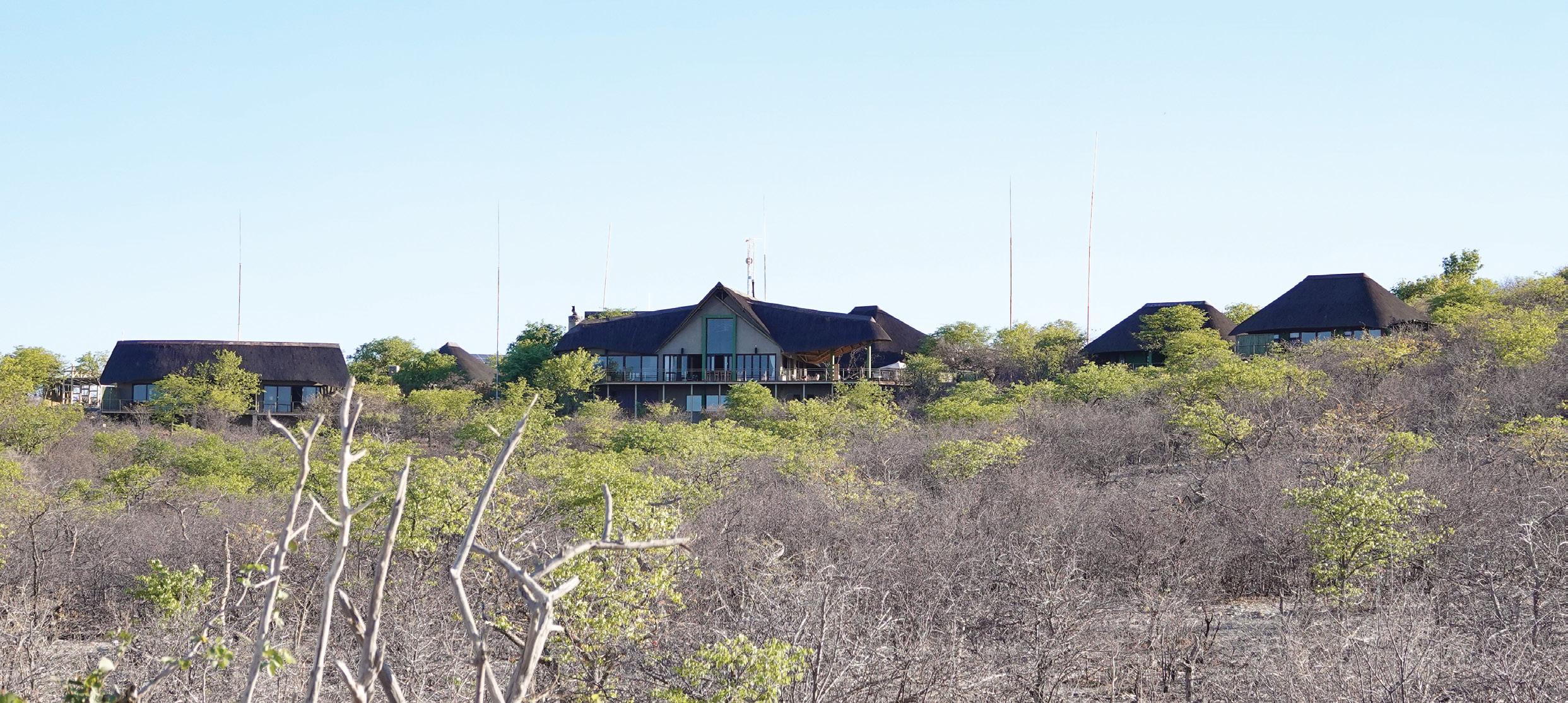
A multidisciplinary team of scientists, conservationists and economists, led by Prof. Morgan Hauptfleisch, has been studying wildlife migration patterns in this region. Using satellite trackers on over 70 animals, they have uncovered a startling truth: animals pay no heed to the man-made boundaries we impose on the land.
Prof. Hauptfleisch is hopeful about the role of private reserves like Etosha Heights in preserving vital wildlife corridors. “Here, we’ve established a semi-open system, a model that could pave the way for something much larger,” he explains. “By connecting commercial farms with wildlifefriendly practices, we can significantly expand conservation areas across Namibia.”
The team’s findings underscore a crucial reality: movement is essential for the survival of these species. In Namibia’s harsh, dry landscapes, animals must roam vast distances to find food and water. Artificial boundaries only restrict their natural instincts to explore and migrate. In an era where climate change is rapidly altering ecosystems, the ability for animals to move freely across the land has never been more critical.


LODGES TO LULL YOU INTO THE RHYTHM OF THE WILD Etosha Heights offers more than just a place to stay; it provides an opportunity to experience the quintessential African safari in a way that feels uniquely yours. Etosha Mountain Lodge and Safarihoek Lodge both boast sweeping 180-degree views of the wilderness, immersing you in the beauty of the vast landscape, where the horizon seems to stretch endlessly.
With its classic bush lodge charm, Etosha Mountain Lodge is a haven of natural wood, earthy tones and understated elegance. Safarihoek Lodge has a more stylish and modern feel, but both establishments invite you to lose yourself in the rhythm of the wild. Whether it is the early morning sight of elephant herds crossing the plain or the tranquil sunset casting golden light over the landscape, the views here are breathtaking.
This is a sanctuary for guests seeking comfort, relaxation and a true connection with nature. The attention to detail is evident in every corner – from the warm, welcoming staff to the meticulously designed rooms that feature extra-large, incredibly comfortable beds, ensuring that every guest feels at home.



Moments like these remind you that this is wild, untamed Africa, and every day here is an adventure waiting to unfold.
As family travel continues to rise, the lodges have thoughtfully embraced this trend, offering family units designed to make travelling with children not only easier but also more enjoyable. Educational toys in the rooms and comfortable lounge areas ensure that both parents and kids can enjoy their stay. The dedicated staff goes above and beyond to ensure everyone is well taken care of, entertaining the kids so that the adults can relax, soak in the views and reconnect with the natural world around them.
Safarihoek Lodge also boasts a two-level hide at an active waterhole. With one sunken and one raised platform, you are offered unrivalled opportunities to photograph wildlife in their natural habitat. Whether you are watching animals cool off in the midday sun or catching a glimpse of the elusive black rhino, this hide allows guests to observe nature up close and in comfort. Equipped with charging stations for cameras, toilets and a cooler box packed by your guide, you can easily spend many happy hours here. For proof of this, you can watch the live stream of the waterhole activity on their website –something which I have since found myself doing whenever the hustle of city life becomes too much.
But make no mistake, this is still untamed wilderness. When we first arrived and were advised not to wander to our rooms alone, especially after dark, we thought the staff were perhaps being a bit overcautious. That is until our guide showed us two lions roaming surprisingly close to our chalets. Moments like these remind you that this is wild, untamed Africa, and every day here is an adventure waiting to unfold.
What truly sets Etosha Heights apart goes beyond the exceptional comfort, luxurious accommodations and the warmth of the staff. It is the visionary approach to wildlife
movement by allowing animals to roam freely across the land in the knowledge that, even as a private landowner, you do not own the land or its wildlife. You are simply blessed by its presence. This respect for nature is woven into every aspect of the experience.
The reserve is deeply committed to conservation, especially in the protection of rhino populations and other vulnerable species. In partnership with researchers and conservationists, Etosha Heights plays an active role in preserving the health of the ecosystem. By removing fences and allowing wildlife to move unhindered, they are contributing to a larger vision of connected conservation areas in Namibia, creating corridors where animals can roam as the original inhabitants of this land.
As you sit there, the warmth of the day still lingering in the air with a hum of quiet energy, it is impossible not to feel a sense of gratitude for this place – a land where nature is revered, and the rhythms of the wild continue uninterrupted.
The endless plains stretch out before you, but it is not just the land you see; it is a living, breathing tapestry of life which you can feel. And as I gaze across the vastness, one thought echoes in my mind: this has been another perfect day in Africa. A day spent immersed in the raw beauty of this wild and untamed land, where I am reminded of how vital our connection to the wild truly is. TN
For more information about Etosha Heights, visit: www. naturalselection.travel
A
In the cool stillness of the early morning, I stood at the edge of the Fish River Canyon, the world awakening around me in shades of gold and amber. The crisp air carried the faint scent of morning mist, and as the first light stretched across the canyon’s rugged expanse, it was as if the earth itself exhaled, revealing its ancient secrets. Plum and lilac purple hues swathed the landscape before me. Below, the winding river shimmered like a silver thread, its course carved over millennia – a testament to time and the raw power of nature.
This is the beginning of many a journey through southern Namibia, a land that feels as untamed as it is inviting. Each destination here whispers a story, from the ghostly remnants of Kolmanskop’s diamond dreams to the saltkissed air of Lüderitz, where history meets the sea. Out on the vast plains of the south, the silhouettes of far-off mountains emerge against a backdrop of endless blue sky.
Southern Namibia is a living, breathing canvas of contrasts, where adventure, history and beauty collide. A place that leaves its imprint on your soul, calling you back long after you have left its sunlit horizons. A land of striking contrasts where deserts meet the Atlantic Coast, ancient histories are etched in stone, and adventure beckons at every turn.
From rugged landscapes to eerie ghost towns, this region offers a unique blend of natural beauty, historical intrigue and endless opportunities for outdoor exploration. Whether you are captivated by rare flora found nowhere else on Earth or seek the solitude of isolated beaches, southern Namibia has something for every traveller.











Kolmanskop, Namibia’s most iconic ghost town, offers a captivating window into the past. Once a bustling diamond mining hub in the early 20th century, it now stands as a silent testament to a bygone era. Guided tours, either in person or via an app, lead visitors through the town’s once opulent world – a place where wealth and luxury once thrived. The eerie emptiness, enhanced by the desert sands slowly reclaiming the buildings, provides photographers with endless opportunities to capture striking, otherworldly shots. A visit to Kolmanskop is sure to linger in your memory long after you have left this hauntingly beautiful corner of Namibia.


Lüderitz, a charming coastal town, was once the epicentre of Namibia’s diamond rush in the early 1900s. Today, it offers a fascinating blend of history and modern-day revival. Nestled between the desert and the ocean, Lüderitz boasts wellpreserved colonial architecture that tells the story of a place where wealth came and went in waves. Visitors can explore its heritage buildings, enjoy the tranquil atmosphere and take in the stunning coastal views.
For a deeper dive into the region’s history, make your way to Dias Point. In 1488, Portuguese explorer Bartolomeu Dias sailed into what we now know as Lüderitz Bay during his momentous voyage around the Cape of Good Hope. To mark his visit, Dias placed an engraved stone and a cross on a rocky outcrop that still stands today, defying the gale-force winds and crashing surf.
Make sure to stop in at Namibia’s first Maritime Museum, housed in the historic Lüderitz Old Power Station on Dias Street. This world-class museum spans five floors and brings the town’s deep maritime history to life, from tales of adventure and survival to the pressing challenges of modern marine conservation. It is a captivating journey through time, shedding light on the seafaring heritage that shaped Lüderitz’s past.
For a different perspective on Lüderitz’s stunning coastal landscape, why not embark on a catamaran cruise? Glide along the waters to see dramatic bays and islands, home to abundant wildlife, including the Heaviside’s dolphin and the African penguin. This serene boat ride offers an entirely fresh view of the untouched beauty of Lüderitz’s coastline and is the perfect way to take in the area’s natural splendour.

The hauntingly beautiful Deadvlei is a must-visit. Its cracked white clay pan, scattered with the skeletal remains of ancient camel thorn trees, creates a stark contrast against the vivid red dunes and cobalt sky.
It is a surreal and otherworldly sight that leaves a lasting impression.
The Fish River Canyon is a must-see for any traveller to southern Namibia. Its sheer size and the interplay of light and shadow on the rugged rocks create a breathtaking visual spectacle. Stretching over 160 km long, 27 km wide, and reaching depths of up to 550 metres, it is the second-largest canyon in the world.
Formed millions of years ago, the canyon offers stunning views and a variety of hiking opportunities. Whether you opt for a day hike or a multi-day trek, you are bound to explore deep gorges and striking rock formations.


Tsau //Khaeb National Park (formerly known as Sperrgebiet National Park) was proclaimed in 2008 and covers 26,000 km² of semi-desert terrain, making it one of the world’s top 35 biodiversity hotspots. Part of the Succulent Karoo biome, which stretches into South Africa, this area is rich in endemic succulent species – many of which are found nowhere else on the planet. Despite being largely undeveloped, sections of the park can be explored with registered concession holders.
The Sperrgebiet, or “forbidden territory”, has been off-limits to the public for nearly a century due to its diamond wealth, preserving its unique and pristine landscape. The park now protects 90% of the remaining Succulent Karoo habitat, home to over 2,400 endemic plant species.
Visitors can experience this untouched wilderness through guided tours, which include the ghost towns of Elizabeth Bay and Pomona, the Bogenfels Rock Arch, and Märchental, the “Fairy Tale Valley” where diamonds were once so abundant they could be picked up by the handful.
Other highlights include day and overnight trips to Dagger Rocks, Douglas Bay and the meteorite impact crater at Roter Kamm, as well as 4x4 dune driving, sandboarding and kayaking in the adventure zone of Oranjemund. Lüderitz serves as the starting point for guided 4x4 excursions into the Namib-Naukluft National Park, with options to visit Saddle Hill, Conception Bay and other historic sites.
No journey to southern Namibia is complete without experiencing the awe-inspiring beauty of Sossusvlei and the Namib-Naukluft Park. Renowned for its towering dunes and stark desert vistas, this region offers a glimpse into one of the planet’s most ancient and pristine landscapes. The dunes at Sossusvlei, some of which reach heights of over 300 metres, are among the tallest in the world. Climbing them at sunrise rewards visitors with breathtaking views as the golden light dances across the rippling sands.
The Namib-Naukluft Park, which encompasses Sossusvlei, is a haven for diverse wildlife adapted to the desert’s harsh conditions. From gemsbok and springbok to the elusive desertadapted brown hyena, life here is a testament to resilience. Whether hiking the Sesriem Canyon, exploring the shimmering salt pans, or marvelling at the vastness of the Namib Desert, this region embodies the raw beauty and grandeur of the south.


Stretching across vast swathes of the Namib Desert, the Namib Sand Sea is a UNESCO World Heritage Site and a truly unique natural phenomenon. It is one of the only places on Earth where fog sustains a thriving desert ecosystem, supporting life in an otherwise arid environment.
This incredible expanse of ever-shifting dunes, sculpted over millions of years, is a geological masterpiece. The interplay of light and shadow on the dunes creates mesmerising patterns, captivating photographers and nature lovers alike. Visitors can explore the Namib Sand Sea through guided 4x4 excursions or scenic flights that reveal its vast scale and intricate beauty from above.
The Namib Sand Sea is not only a visual spectacle but also a reminder of the delicate balance of life in the desert, making it a must-see for anyone exploring the wonders of southern Namibia.

Southern Namibia is a paradise for outdoor enthusiasts. The Fish River Canyon offers one of Africa’s top hiking trails, a challenging 85-km trek through deep ravines and rocky terrain. For a more moderate experience, there are several slackpacking options with Fish River Lodge.
Despite the region’s arid nature, there are several options for water-based activities. Hardap Dam near Mariental is popular for freshwater fishing, with species like bass, carp and yellowfish. Lüderitz, known for its strong winds, is a global hotspot for kitesurfers and windsurfers. For a unique adventure, try a multi-day canoeing trip along the Orange River, where you can take in stunning desert views.
The vast sand dunes of southern Namibia are an enticing challenge for adventure seekers. Guided concession tours into the Namib Sand Sea and along the Atlantic Coast offer an immersive and thrilling expedition for those looking to gain an intimate desert experience.
Due to the ever-changing nature and sensitivity of the dunes and desert biomes, these stunning landscapes are best explored with an experienced guide who knows the terrain.






Our purpose is to help conserve the landscapes of Namibia, to protect the wildlife, and to improve the lives of the people we work with through sustainable innovative commercial activities.



Years of evidence-based conservation research have reduced human-wildlife conflict, established more than 100,000 hectares of protected habitats, and provided countless animals with a second chance.

The N/a’an ku sê Foundation strives to empower Namibia’s San and other communities. The N/a’an ku sê Schools and the N/a’an ku sê Lifeline Clinic are crucial to these efforts.






The N/a’an ku sê Ecotourism Collection – where conservation influenced the establishment of bespoke lodges in some of Namibia’s most iconic locations.



The southern region is dotted with towns that provide insights into Namibia’s colonial past. Keetmanshoop, for instance, is home to the Rhenish Mission Church and the Eagle Monument, which commemorate the town’s early history. In Aus, visitors can explore the Commonwealth Cemetery, which honours those who died during World War I and of the Spanish flu pandemic. Bethanie boasts some of the oldest buildings in the country, including the Schmelenhaus, built in 1814.
For those intrigued by history and the remnants of past industries, the ghost towns of southern Namibia offer fascinating exploration. In addition to Kolmanskop, there are other abandoned mining camps and towns such as Elizabeth Bay and Pomona, where the ruins tell the story of the diamond rush era and the once-thriving mining communities that vanished when resources ran dry.
The coastline of southern Namibia is famous for its shipwrecks. In 2008, a significant find of gold coins, ivory tusks and silver artefacts was uncovered from a Portuguese shipwreck off the coast. The Tsau //Khaeb National Park’s remote and untouched nature makes it an exciting place for those interested in maritime history and treasure hunting. The newly opened Maritime Museum in Lüderitz is rife with treasures and intrigue.

Southern Namibia is a land where adventure and history converge, and natural wonders await at every turn. From the vastness of the Fish River Canyon to the ever-changing coastline and the unique desert wildlife, the region offers something for every traveller. Its untouched landscapes, rich cultural heritage and thrilling outdoor activities make southern Namibia one of the country’s most captivating and rewarding destinations.

Text & Photographs Kirsty Watermeyer

As I gaze upon the land from a distance, the vastness of the Namib stretches out endlessly before me. Up close, the landscape is an amalgamation of gravelly sand, tufts of dried grass and the stark silhouettes of blackened mountains. Somehow, these simple elements of nature harmonise in perfect balance.
It is in the seamless orchestration of all these elements that the beauty is found. Much like a symphony where each note finds its place in a greater whole. In the desert, every individual detail is crucial to the song it sings collectively.
Even the smallest creatures, like the Namib Desert beetle –also known as the “toktokkie” or “head-stander beetle” for its unique method of collecting water – play a crucial role in the ecosystem. They feed on decaying matter, recycle nutrients and contribute to soil health. If you were to remove them, despite their minute size, it would have far-reaching effects on other species who feed on them, disrupting the entire system.
And then there is the other dimension to this land, the one that reveals itself in moments of raw, breathtaking power. A sandstorm sweeps across the plains, transforming the landscape into something almost otherworldly. The wind moves the sand like brushstrokes on a canvas, creating sweeping zebra stripes of golden dunes across the barren gravel plains. It is a mesmerising, mind-blowing display of nature’s force – chaotic yet beautiful.
THE SUM OF ITS PARTS
The Namib Desert is a finely tuned ecosystem, where everything plays a vital role in maintaining the balance of the delicate web; a harmony that can easily be disrupted. I travelled to the Kulala Wilderness Reserve to witness this complexity and have a look at the Kulala Rehabilitation Project which is aimed at restoring the landscape – once fragmented and fenced farming land – to its original state. This restoration project is not just an act of environmental stewardship, but a deeper recognition of the profound interconnectedness of all life in this remarkable landscape.
My home during this visit was Wilderness Kulala Desert Lodge, a warm, family-friendly retreat that offers an immersive desert experience. With its laid-back atmosphere, the lodge invites you to relax and truly connect with the rugged beauty of the surrounding landscape.
The staff went above and beyond to make our stay memorable, even providing us with a personalised map highlighting recommended routes when they learned we were driving there ourselves. It is the thoughtful, small touches like these that made the experience feel extra special. And then there is the dining – some of the freshest, most delicious food I have had, served under the vast desert sky, followed by stories of the land shared around a crackling campfire.
While every moment at this luxurious lodge was a pleasure, it sparked within me a deeper curiosity about the finer details of the rehabilitation project underway here.
THE KULALA REHABILITATION PROJECT
Eager to learn more upon my return, I sat down with the Wilderness Namibia Impact Team to gain further insight into their vital work. Hamish Hofmeyr, operations manager, Gerhard Thirion, environmental officer, and Dr Conrad Brain, sustainability and conservation officer, regaled me with stories which added an even deeper layer to what was already an incredibly rich and multi-faceted narrative.
According to Thirion, “Kulala is part of a bigger picture within the entire ProNamib, which has been rehabilitated to a point where it became how it used to be.” The ProNamib Nature Reserve is a large-scale conservation project aimed at restoring nature in Namibia’s desert landscape.
In arid conditions, wildlife must be able to move freely to access food and water sources, especially during periods of severe drought. The restoration of the natural migration corridors is critical for the survival of desert-adapted species.
Hofmeyr explains, “The goal was to restore the natural behaviours of these species. Animals like gemsbok, for example, may travel many kilometres in search of food and water. Without access to these migration routes, they would have nowhere to go, and the population would decline significantly.” In the Namib Desert, mammals generally lead a nomadic existence, responding to the unpredictable rainfall and food availability by moving between the plains, dunes and the Namib Escarpment.
The Namib Desert is home to a remarkable array of species, many of which are found nowhere else on Earth. These endemic creatures depend on the fragile balance of the desert ecosystem. Take the Peringuey’s adder, for example – perfectly adapted to its environment, it lies buried in the sand, with its unique eyes positioned on top of its head, waiting for prey to come within striking range.
As Hofmeyr points out, “If there’s rainfall in a five-squarekilometre area, somewhere in the dunes you’ll suddenly find 100 animals in that small space, while around it, there’s absolutely nothing.” Dr Brain further emphasises that the desert is not only home to endemic species but also provides a critical sanctuary for others, such as the Lappet-faced Vulture. This species depends on the Namib’s remote landscapes for safe breeding grounds. “One vulture, tracked over time, has already travelled more than 97,000 kilometres. Remarkably, it returns every year to breed in the very same area where you stayed at Kulala Desert Lodge,” he says.
As overgrazing by small stock was reduced and the composition of grass species improved, a remarkable transformation unfolded within the Namib Desert ecosystem. The return of wildlife, once driven away by habitat degradation, signalled a turning point for the region’s biodiversity.
In this hyper-arid environment, even the smallest disturbances can leave lasting scars, and even the smallest tracks left in the desert’s delicate crust can persist for centuries. As Dr Brain explains, “As soon as you go up in an aeroplane, you can actually see the visual scarring of the landscape.” One of the most damaging activities is off-road driving. Many birds, for example, nest on the ground in these gravel plains, blending in perfectly with their surroundings.
Meanwhile, conscious travel has the power to ensure these places can remain unspoilt. This is deeply tied to the

responsible tourism model that Wilderness promotes. By encouraging low-impact, conscious travel, they help sustain both the environment and local communities. Hofmeyr says, “Ultimately, our goal is to help conserve as much land as possible. We use tourism as a vehicle to achieve this. If we don’t conserve these areas, there won’t be anything for future generations to enjoy. And the people who live here will lose the very thing that makes their land so unique.”
As guests visit places like Kulala Desert Lodge, they are encouraged to understand their role in preserving these fragile environments. With sustainable travel at the core of the Wilderness philosophy, the company works diligently to minimise its environmental impact, ensuring that the habitats which travellers come to experience remain intact.
Thirion adds that tourism plays a crucial role in the region’s economy. “Every dollar earned by a staff member in a camp in one of our remote areas sustains about 12 people,” he notes, adding that beyond the economic benefits, tourism can also provide an avenue for education and awareness.
The Kulala Wilderness Reserve stands as a proud conservation success story, showcasing the positive impact of responsible, low-impact tourism. Through tireless efforts to restore ecosystems and protect the remarkable wildlife that calls this fragile environment home, Wilderness is ensuring that the Namib Desert remains a thriving sanctuary for biodiversity. Over the years, careful and sustainable management has transformed this land into a flourishing habitat where endemic species can once again thrive. Today, spanning 27,000 hectares, the reserve is home to a rich variety of arid-adapted wildlife. The sensitive landscape has flourished thanks to Wilderness’ ongoing commitment to biodiversity conservation.
The Namib Desert, one of Africa’s most extreme and aweinspiring landscapes, is home to a unique array of species that have evolved to survive in one of the world’s driest environments. Through their dedication to conservation, Wilderness is playing a pivotal role in preserving this natural

sanctuary. As the desert endures, so too does the promise of a living, breathing ecosystem.
The future of these wild places depends on conscious travel, sustainable tourism and the collective efforts of communities, conservationists and visitors alike.
The promise of conscious travel offers hope, not just for today’s explorers, but for the wildlife that will depend on this place in the future. TN
For more information about Wilderness Kulala Desert Lodge, visit: www.wildernessdestinations.com









Tel: +264 61 309 141

Email: reservations@thewindhoek.com www.thestellenboschwinebar.com www.tastingroom.com.na www.hillsidewindhoek.com www.thewindhoek.com

The NamibRand Nature Reserve has made history as Africa’s first Wilderness Quiet Park, a prestigious recognition that underscores the reserve’s commitment to responsible, noise-conscious tourism. Awarded by Quiet Parks International (QPI), NamibRand became only the fourth location worldwide to receive this honour. The Wilderness Quiet Park accolade recognises vast, pristine areas offering exceptional sonic beauty and extended periods of natural quiet – a rare and modern luxury that enhances both human wellbeing and ecological health.
In a world where noise pollution is ever-growing, the preservation of quiet places has never been more important. NamibRand offers a sanctuary where both humans and wildlife can experience an environment free from the distractions and stress of modern life.
Nils Odendaal, the chief executive officer of the NamibRand Nature Reserve, explains that embracing quiet spaces is part of a comprehensive approach to conservation. “Noise is a form of pollution that, if left unaddressed, can have detrimental effects on the environment. Often, issues like noise and light pollution are overlooked in favour of focusing on more iconic wildlife, such as rhinos and lions. However, to be truly effective, conservation must take a holistic approach that addresses all aspects of the ecosystem,” he says.
The physical and psychological benefits of silence are well documented. QPI highlights how immersion in a
quiet environment can reduce stress, improve focus, ease anxiety and inspire creativity. For visitors, the tranquillity of NamibRand offers a chance to reconnect with nature and recharge, both physically and mentally.
“Quiet places promote peace and tranquillity,” adds Odendaal. “They provide an opportunity for visitors to connect with nature in a way that nurtures both body and soul, healing them from the stresses of modern life.”
The selection process for QPI’s Wilderness Quiet Park status is rigorous. It involves detailed sound monitoring to assess sonic disturbance levels in a given area. Edward Alant, a representative from QPI, installed sound recording equipment at multiple locations within the reserve, measuring ambient sound levels.
“The results were so exceptional that NamibRand was recommended for certification as a Wilderness Quiet Park – QPI’s highest accolade,” Odendaal explains. “This certification reflects the outstanding sonic beauty and natural quiet that define NamibRand, providing an environment free from the disruptive forces of noise pollution.”
According to Odendaal the award is a reflection of the reserve’s comprehensive approach to environmental conservation. “This recognition underscores NamibRand’s commitment to a holistic conservation strategy,” he says.
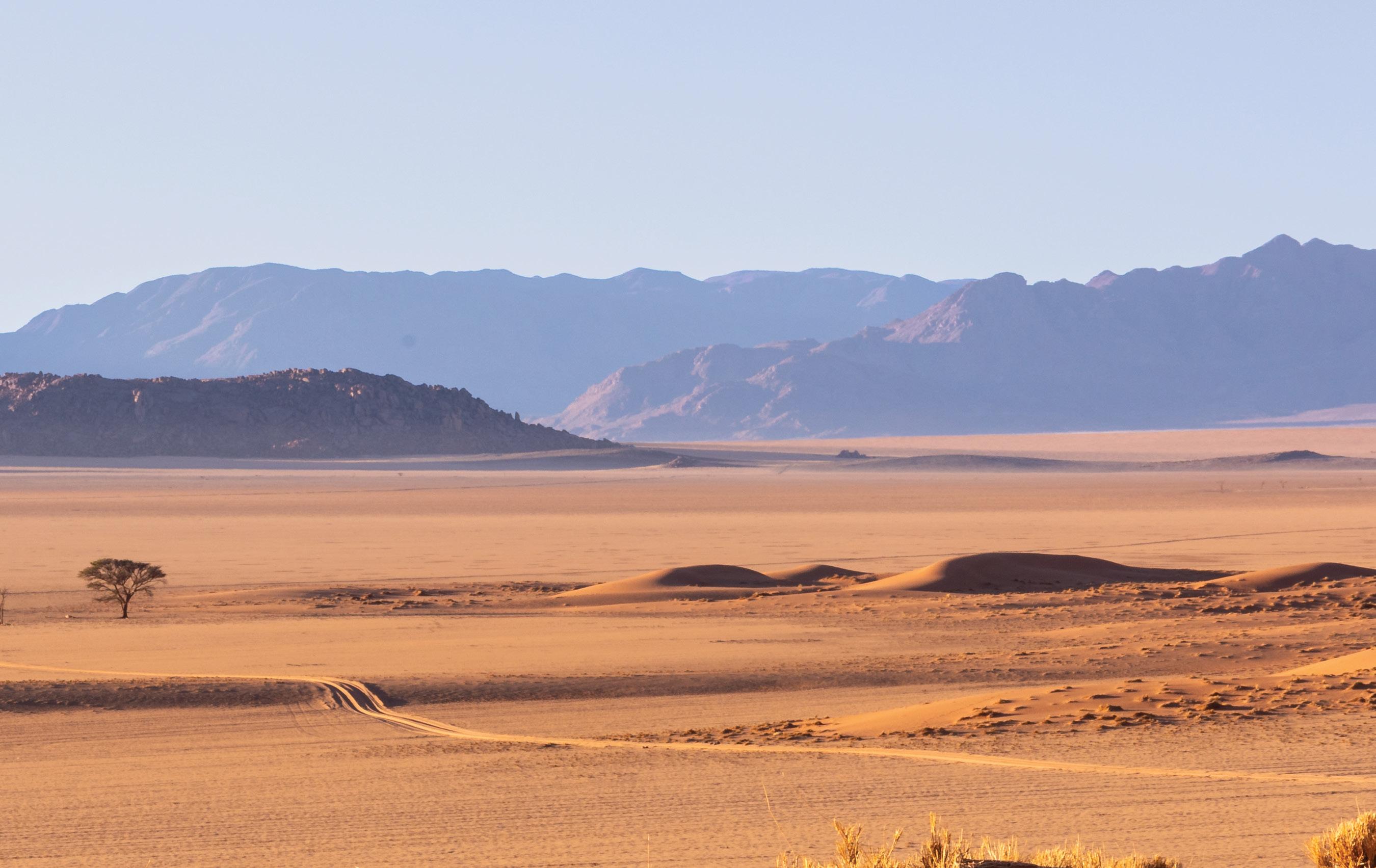
“Rather than artificially stocking the reserve with wildlife or man-made attractions, our focus is on restoring the area to its natural state, which we believe will yield long-term ecological benefits.”
NamibRand’s dedication to a balanced conservation approach extends beyond its boundaries. The reserve is a founding member of the Greater Sossusvlei-Namib Landscape Association (GSNL), a collaborative effort where like-minded landowners and custodians join forces to protect biodiversity and support socio-economic development across the region.
NamibRand is also working closely with national and international organisations to raise awareness about the importance of preserving quiet spaces and to encourage the adoption of noise-reduction practices. As a member of the Namibian Chamber of Environment (NCE) and the International Union for Conservation of Nature (IUCN), the reserve plans to leverage these platforms to amplify the message about the value of quiet spaces – not just in Africa, but globally.
For those unfamiliar with the concept of Wilderness Quiet Parks, NamibRand offers a rare opportunity to experience something truly unique: an environment that is not only visually breathtaking but also acoustically pure. As noise pollution becomes more pervasive, places like NamibRand
provide an invaluable escape from the clamour of the modern world, allowing visitors to truly listen to nature’s voice.
“Quiet places are essential for both nature and the human soul,” says Odendaal. “They promote relaxation, rejuvenation and inner peace. Experiencing this profound quiet, especially in a place like NamibRand, is a rare gift – one that allows people to reconnect with themselves and with the natural world in a deeply meaningful way.”
In a world that grows ever louder, NamibRand offers a rare chance to experience the restorative power of quiet. It is a sanctuary where time slows down, the sounds of nature take centre stage and visitors can reconnect with the raw, untouched beauty of the Namibian wilderness. TN
NamibRand raises vital funds for conservation by collecting a levy from guests who stay overnight at one of its partner lodges within the reserve. Accommodation options cater to various budgets, from the more affordable NamibRand Family Hideout to the luxurious offerings at Wolwedans Collection and Kwessi Dunes Lodge.
To learn more about these tourism operators or to make a reservation, visit www.namibrand.org/tourism.



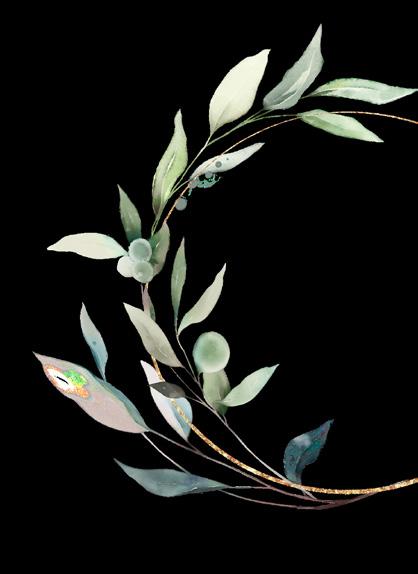






Bagatelle Kalahari Boutique Farmhouse www.bagatelle-lodge.com/farmhouse/

Bagatelle Kalahari Game Ranch www.bagatelle-lodge.com
Büllsport Lodge & Farm buellsport-naukluft.com

Cornerstone Guest House www.cornerstoneguesthouse.com

Corona Guest Farm www.coronaguestfarm.com

Divava Okavango Resort & Spa www.divava.com

Etusis Lodge www.etusis.com
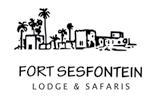
Fort Sesfontein www.fortsesfontein.com







Frans Indongo Lodge www.indongolodge.com


Guest Farm Kiripotib www.kiripotib.com
Gecko Ridge www.geckoridge.com.na





Goibib Mountain Lodge www.goibibmountainlodge.net
Huab Lodge www.huab.com
Jackalberry Tented Camp www.jbcamp.com
Kashana Namibia www.kashana-namibia.com
Mirage Resort and Spa www.mirage-lodge.com










Namib’s Valley Lodge www.namibsvalley.com
Ndhovu Safari Lodge www.ndhovu.com
Nkasa Lupala Tented Camp www.nkasalupalalodge.com
Ongula Village Homestead Lodge www.ongula.com
Ohange Lodge www.ohange.com
Otjiwa Eagle’s Rest www.otjiwa.com.na
Otjiwa Mountain Lodge www.otjiwamountainlodge.com
Serondela Lodge www.serondelalodge.com
Ugab Terrace Lodge www.ugabterracelodge.com

A whale of a day

The water was like glass – clear, calm and serene – as we set off from the Walvis Bay waterfront aboard the Olin with Mola Mola Safaris. The air was thick with anticipation. While we knew we would encounter the usual array of marine life, our hopes were set on something more elusive: the chance to witness majestic whales from up close.
Whale sightings in Walvis Bay and along the Namibian coast are becoming more frequent as populations slowly recover from the near destruction they faced during the peak of whaling in the 19th century. Walvis Bay, once known as the “Bay of Whales” over 250 years ago, saw these magnificent creatures nearly driven to extinction. Today, however, whale species are protected by Namibian law within its waters. After more than seven decades of absence, whales were first spotted again 50 kilometres off the coast, but in 2021, a remarkable turning point came – whales began to return to Walvis Bay itself.
While several species of whales can be found in Namibian waters, the Southern Right and Humpback whales are the most commonly seen. Both species are currently listed as endangered, making the opportunity to witness them all the more special. Humpback whales can weigh between 35 and 45 tonnes and are known for having the longest flippers of any whale species.
We cruise out of the harbour with expert skipper Wian Bornman and his righthand man, Sami Ulami. The two are a delight – always ready with a joke or a helping hand. Wian’s deep knowledge of the sea turns even the quiet moments into something full of intrigue. At one point, he turns to me and says, “It’s not actually the prime time for whale sightings; they would normally have already migrated to colder waters after breeding. But for the last two weeks, they’ve been spending time off the coast of Namibia, and I have a feeling that today we’re going to be lucky.” It is such a perfect day that seeing whales would be the quintessential “cherry on top”.
It is a short and smooth journey through the harbour and along the peninsula, where we are joined on board by seals, pelicans and seagulls. Wian and Sami seem to know most of the marine life willing to venture so close by name. Wian regales us with fascinating stories about each species, sharing fun facts like how pelicans have a wingspan of over three metres, or that Cape fur seals get their name from their thick fur, which is the fifth thickest fur on Earth.







Once we venture out to sea, the waves take on a much greater intensity than along the peninsula. As the spray lightly salts our faces, our eyes remain fixed on the horizon, eagerly searching for any sign of a whale’s blow. Our hearts race, cameras are ready, and the excitement in the air is palpable. We watch in silence, hoping, when suddenly Sami shouts.
“There! Whales!” He points to a patch of water that, at first glance, looks no different from the waves around it. We all focus intently on the spot, and then – almost magically – the dorsal fin of a massive Humpback whale breaks the surface, and our hopes are realised. The boat erupts in cheers, but now the pressure is on. Everyone wants a perfect shot of this majestic creature, knowing full well it could vanish into the vast ocean at any moment. Sami, just as eager as we are, scans the waters, trying to predict where the whale will surface next. When he spots it, he calls out excitedly, and as the whale dives again, he turns to us and asks with a grin, “Did you get it? Tell me you got that!”
The frantic scramble for the perfect picture quickly fades, and a profound calm settles over our boat. What had been a moment of anticipation and excitement transforms into something far more meaningful. We are no longer focused on capturing the perfect shot; instead, we are fully present in the experience. Around us is a breeding pod of humpback whales – mothers and babies, so many of them. The sight fills us with a sense of peace, and we drift silently in the water, engines off, careful not to disturb the whales. What began as eager anticipation, then shifted to pure excitement, has now deepened into a quiet appreciation and solemn awe that envelops us all.
Our skipper, Wian, is highly mindful of not disturbing the whales. He keeps a careful watch on how we interact with them, ensuring that we do not get too close and that the engines are always off when they are nearby. The whales move with astonishing grace and speed, and giant ripples on the water reveal the direction in which each whale is travelling.
There is something profoundly affecting about being with the whales. It feels as though their deep, gentle wisdom has somehow seeped into our beings, leaving us calmer, kinder and even a little wiser. It is hard to do anything but reflect as we begin to depart from this extraordinary experience. After a short ride back along the peninsula, our boat lands on the beach, where a feast awaits us. We disembark in near silence, still wrapped in the quiet reverence of the moment. But once we set foot on land, an eruption of joy bubbles to the surface, and our giddy happiness is impossible to contain. In an instant, we are no longer strangers. We are all friends, sharing laughter and warmth with people who, just a short while ago, were unfamiliar faces.
We are about to enter a new chapter of our day; one I would call “The Feast of Kings and Queens”. Awaiting us on the beach is a beach braai fit for royalty. We are greeted by fresh oysters and sparkling wine, followed by succulent Namibian beef fillets straight off the fire, as well as tender, freshly grilled crayfish. There is also warm, buttery garlic bread and a selection of scrumptious salads to complete the spread. We settle in to enjoy a delicious meal, sharing stories and laughter as we continue to be pampered by the charming Mola Mola Safaris duo of Pieter and Bianca Burger who, with a smile, assure us they are not related and who go out of their way to keep the atmosphere light, joyful and full of warmth.
After we had eaten our fill and then some more as we savoured perfect coffees alongside an extensive dessert platter, our skipper returned to shore to collect us for one final cruise along the peninsula. Along the way, he continued to share fascinating facts about marine life, mixed with jokes that landed perfectly every time. Our group of intrepid adventurers, hailing from all corners of the globe, did not for a moment lose that giddy happiness. Even as we disembarked the boat, our smiles were impossible to contain. It had been an incredible day in what is truly the jewel of the Namibian coast. TN














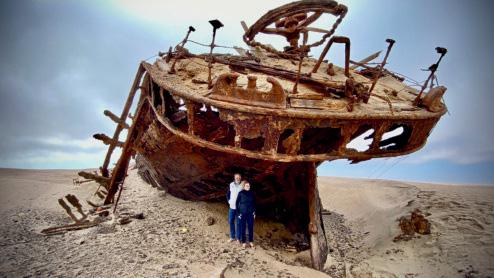







INTO THE OLDEST DESERT ON EARTH, THE NAMIB, AND ENJOY THE FREEDOM AND VASTNESS IT OFFERS.










THE ICONIC TOWERING SAND DUNES THAT PLUNGE INTO THE OCEAN ALONG NAMIBIA'S BARREN COASTLINE THE HIDDEN GEMS OF THE SPERRGEBIET, WITH THE HIGHLIGHT BEING A STOP AT BREATHTAKING BOGENFELS
+264 (0) 81 129 5393 dolphin@namibiancharters.com
+264 (0) 81 147 3933 info@sandwich-harbour.com



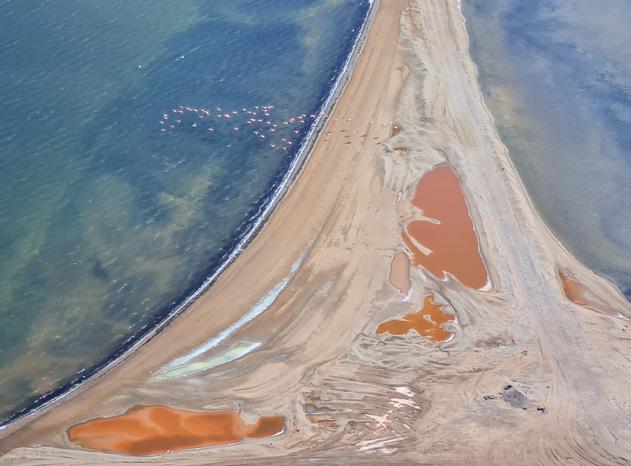
THE SOUTH ATLANTIC OCEAN ON OUR CATAMARANS OR KAYAKS IN SEARCH OF THE NAMIBIAN MARINE BIG 5
+264 (0) 81 143 9837 info@adventuretravelnamibia.com At Bush Bird Aviation/Sossusfly, we specialize in breathtaking scenic flights over Namibia’s most iconic landscapes. From the sweeping dunes of the Namib Desert to the rugged Skeleton Coast, our flights offer an unparalleled aerial perspective. With seamless pick-ups and drop-offs from lodges and the ability to land anywhere with an air strip we make your journey easy. Our signature Sossusfly flight covers 630 km, with less than 20% of this spectacular terrain visible from the ground. Experience Namibia’s hidden beauty – book your flight today!



By Elzanne McCulloch
As the first rays of sunlight pierced the morning mist, I found myself gliding silently along the glassy waters of the Chobe River. The sounds of the wild surrounded me. The grunt of a hippo, the distant call of a Fish Eagle, and the soft splash of water as a crocodile quietly slid into the water off the riverbank. As we explored the waterways, elephants emerged from the trees to drink along the river’s edge, their graceful presence mirrored in the water below.
This is Namibia’s Zambezi Region, formerly known as the Caprivi Strip – a verdant paradise tucked into the northeastern corner of the country. Unlike the arid deserts and rugged landscapes of Namibia’s south and west, the Zambezi Region is alive with rivers, wetlands and forests. It is a haven for wildlife and a crossroads of culture, where Namibia meets Angola, Botswana, Zambia and Zimbabwe.
The Zambezi Region is a sensory experience. Here, the rivers pulse with life, the sunsets set the sky ablaze, and every moment feels like a step into nature’s most vibrant showpiece.



Stretching over from the Kavango East Region, Bwabwata National Park is the heart of northeastern Namibia, a unique conservation area where people and wildlife coexist. The park spans both dry woodlands and lush floodplains, creating a mosaic of habitats for diverse species. Made up of three core areas – Mahango, Buffalo and Kwando – visitors to the park can spot elephants, buffalo and antelope such as kudu, lechwe and sable during game drives, while the Okavango River in the west and Kwando River in the east are magnets for hippos and crocodiles. Bwabwata is also a birder’s paradise, home to over 400 bird species, including the striking African Skimmer and the rare Wattled Crane.
Nkasa Rupara National Park, often called the “mini-Okavango”, is Namibia’s largest wetland area. This pristine wilderness of reed beds, lagoons and islands comes alive during the rainy season, attracting massive herds of elephants and buffalo. The park’s remoteness offers an intimate and uncrowded safari experience, perfect for adventurous travellers seeking solitude and close encounters with nature. Here, predators roam between Namibia and our southern neighbour Botswana, with possible sightings of lion and leopard. The terrains can be hard to access, especially during the wet season, and must never be attempted with only one vehicle.



Malachite Kingfisher
The mighty Zambezi River, one of Africa’s most iconic waterways, flows through the region, providing endless opportunities for exploration. Visitors can enjoy boat cruises to see wildlife along the banks, try their hand at tiger fishing or simply soak in the tranquil beauty of the river at sunset.
The Zambezi Region is home to vibrant cultural communities, including the Lozi, Mbukushu and Mafwe people. Visitors can explore cultural villages to learn about traditional crafts, music and storytelling, or shop for unique handmade wares along roadsides and at craft markets. These experiences provide a deeper connection to the region and its people.
Glide along the Okavango, Kwando, Linyanti, Chobe or Zambezi rivers for unforgettable wildlife encounters. From spotting herds of elephants crossing the river to watching a pod of hippos basking in the shallows, these water-based safaris offer a unique perspective on the region’s incredible biodiversity.
Explore Bwabwata or Nkasa Rupara National Park on a game drive or guided walk, on offer at most lodges. Expert guides lead you through the region’s rich ecosystems, offering insights into the flora, fauna and unique adaptations of the wildlife.
Anglers flock to the Zambezi Region for the chance to catch the ferocious tiger fish, a prized freshwater species known for its strength and speed. Whether you are a seasoned fisherman or a curious beginner, the rivers of the Zambezi Region promise an exciting challenge.
With its wetlands, woodlands and rivers, the Zambezi Region is a haven for bird enthusiasts. Keep an eye out for Carmine Bee-eaters, African Fish Eagles and Pel’s Fishing Owls among the hundreds of species that call this region home.




The Zambezi Region offers some of Namibia’s most intimate and aweinspiring wildlife encounters. Elephants, hippos, lions and buffalo roam freely across this water-rich wilderness, moving between Namibia and its neighbouring countries. Observing these animals in their natural habitat is a privilege that requires care and respect.
Visitors are encouraged to experience wildlife responsibly, whether on a guided game drive, river cruise or walking safari. Keep a respectful distance, remain quiet and allow the animals to behave naturally. The region’s ecosystems support not only iconic species but also rarities like the elusive sitatunga antelope and the shy bushbuck. These encounters are a testament to the region’s ecological richness and the success of crossborder conservation efforts.
The Zambezi Region is a vital part of the Kavango-Zambezi Transfrontier Conservation Area (KAZA), the largest transboundary conservation area in the world, spanning five countries: Namibia, Angola, Botswana, Zambia and Zimbabwe. At the heart of this ambitious initiative lies a commitment to preserve wildlife corridors, support community-based conservation and foster sustainable tourism. In the Zambezi Region, this means unparalleled opportunities to witness the free movement of elephants, buffalo and other wildlife across national borders, showcasing the success of collaborative conservation. Visitors to this region contribute directly to these efforts, helping ensure the long-term survival of the region’s ecosystems and species. KAZA is a symbol of unity, protecting the interconnectedness of nature while uplifting local communities who call this remarkable region home.
Namibia’s Zambezi Region is a place of contrasts and connection. A place where rivers and forests meet, where wildlife and culture thrive side by side and where every moment feels alive with possibility. Whether you are gliding through its waterways, exploring its parks or immersing yourself in its vibrant traditions, the Zambezi Region promises an adventure that will linger in your heart long after you leave.
Come and discover the Zambezi – a lush corner of Namibia that brims with life, beauty and endless wonder.











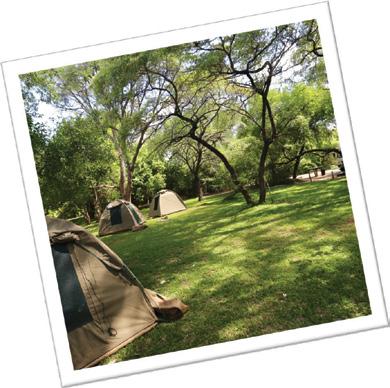
En-suite tree houses, camping, swimming in the river, shade, grass, wildlife, mokoro safaris, funky ablutions, and so much more…. Reservations: +264 81 202 8200 bookings@ngepicamp.com www.ngepicamp.com








Where your feet are in nature...












When I close my eyes, I am transported back to a moment so profound, it feels as if it will remain etched in my soul forever. In that moment, I lose myself in a gaze. Eyes pierce right through me, stirring something deep within. Their markings are striking, yet blend seamlessly into the environment, as if they are part of the very air around them. And then, there is their unexpected playfulness.
Text & Photographs Kirsty Watermeyer
I have always had a deep love and fascination for leopards. I remember watching a documentary years ago that highlighted their incredible hunting abilities, their ferocity and their reclusive nature. How could I know anything different? Who gets the chance to spend time with a leopard in the wild? Very few. For most people, the fleeting sight of a leopard is such a rare occurrence that it would be forever marked as a moment of great significance.
Like most people, my knowledge of leopards was limited to folklore and imagination, until I had the chance to join a leopard tracking experience at Okonjima Nature Reserve. Spanning 20,000 hectares, the reserve is home to around 35 leopards, 18 of which are fitted with tracking collars. These trackers do not provide exact locations but only a general direction, meaning a sighting is never guaranteed. Leopards are incredibly stealthy and rarely allow themselves to be seen.
One crisp morning, we departed from the lodge under the guidance of Martin, the head guide at Okonjima. With twelve years of experience here, he has a deep understanding of –and respect for – the leopards that call this beautiful place home. After a short drive, we begin to pick up beeps from the tracking collars. We scour the ground but see nothing. We push on, searching deeper and deeper. Jittery animals tell us we must be on the right track – surely, a leopard is close. Or is it? Just as I am about to give up, something catches my eye; something so exquisite, my brain takes a moment to realise it’s a leopard!
Martin tells us that she is a female, and that she has a tenmonth-old male cub who is obviously somewhere else. After a brief assessment of her behaviour, he deduces that she is not hunting – she is marking her territory.

Careful not to disturb her, Martin keeps his distance, turning off the engine whenever she pauses, allowing us to simply observe. She sniffs at branches, inspects the land, rubs against trees, rolls in the sand and continues her morning routine.
The precious time spent with her is the most incredible experience. I feel as though I am walking in the footsteps of David Attenborough, almost hearing his voice narrating the moment: “Such beautiful movement is rarely seen. Dance in the animal world is little understood.”
We spend an unbelievable amount of time watching the leopard’s every movement – so much so that I almost start to relax into the moment, as though spending time with a leopard in the wild is a normal, natural thing. But it is almost time to head back to the lodge for breakfast. Martin asks if we can move on, as he wants to take us around the mountain on the return drive. We take one last feast for the eyes before heading towards the higher ground, completely unaware of what awaits us.
As we reach the viewing spot atop the mountain, we are all taken by surprise. There, enjoying the very view we had come to see, is the female’s cub. Uncollared and entirely unfazed, he appears as relaxed as anyone could hope for when encountering a leopard.
We were so unaware of him when we arrived that our car stopped right next to him, but he did not flinch. There he lies, locking eyes with me, then turning his head a few times, almost as if posing for my camera. A yawn, a wink, a pose... And then, leisurely, he gets up and moves a little closer. He sits down again, a hair’s breadth from the vehicle, and simply stays there, looking at me. It is as though he is talking to my
soul, stirring something deep and spiritual that will linger within me for many moons to come.
Although only ten months old, this cub is already as big as his mother and destined to become a formidable leopard one day. For now, he is content to show off his flawless markings and curious nature. After inspecting us closely, he moves to the edge of the mountain, turns around, and flops down onto the red rocks, presenting the perfect photo opportunity.
Once he has had his fill of our attention, he gets up and begins making his way down the other side of the mountain. We follow him along the road, and park to watch him jump from rock to rock, stopping a few times to strike a few more stunning poses before disappearing from view. We are filled with a mix of adrenaline, reverence, excitement and awe as we head back to the lodge – as though we are returning to earth from some otherworldly experience. It was such a magical moment that, upon our arrival at camp, I immediately signed up to do it all again the next morning.
Before the next experience, I got the chance to speak to Karen Codling, the director of the AfriCat Foundation, about the research being conducted at Okonjima. She explains that their research focuses on understanding the long-term behaviours of the animals here. “We’re fortunate to have close access to species like leopards, which allows us to observe their social dynamics in unique ways. For example, we’re seeing that leopards interact with each other more than we originally thought, even sharing prey about a third of the time. We’ve also seen surprising familial behaviours, like male leopards continuing to interact with their grown sons,” she says.
“Our primary focus is on leopards, pangolins and brown hyenas. The brown hyena remains an enigma – we’re just
beginning to study them. It’s fascinating how much we don’t know until we start looking.”
Karen continues, “Being able to observe these animals in their natural habitat is a huge privilege. Leopards, pangolins and hyenas are all nocturnal, shy and solitary creatures. To be allowed into their space, to truly understand them, is something we must never take lightly.”
“Our research is about answering questions that others can’t”, she adds. “We are able to observe these animals in ways that aren’t possible elsewhere, and that has drawn international researchers to us. They come with questions they have not been able to answer, and through collaboration, we’re able to add valuable insights.”
“Leopards, in particular, have surprised us. There’s so much in the literature that says they don’t do certain things, yet we’ve observed them doing exactly the opposite. It challenges what we thought we knew. We’re not just collecting data – we’re questioning assumptions and exploring new possibilities.”
The next morning, Martin takes us out again, this time to another part of the vast reserve, a different territory and, hopefully, another leopard. It is not long before we spot a dominant male, fresh from a successful hunt. Our eyes follow the drag marks in the sand, leading us to where he lounges lazily beneath a thicket. After watching him for a while, we decide to leave him in peace.
Next, we track the signal of another leopard, following the beeps as we drive deeper into thick bush. But despite our best efforts, the signal leads us nowhere. We comb the area again and again, but the elusive cat remains hidden. Eventually, the search gets abandoned. A humbling reminder that a sighting is never guaranteed, it is a gift.
We were hoping for just one more sighting, and Martin was eager to try again. We set off in a new direction, toward another leopard’s territory, hoping for better luck. This time we were rewarded. A mother and her one-year-old cubs – a male and a female – were on the move, searching for a new resting spot.
We followed them as they moved along the riverbank. What unfolded before us was incredible – an opportunity to see firsthand how playful leopards actually are. The cubs pounced and taunted each other with infectious energy. Then, in a rare moment of tenderness, when the vegetation thinned and they became more exposed, the young male cub would walk alongside his mother, gently wrapping his tail around her body in an affectionate gesture – almost like a tail hug.

For more information about AfriCat Foundation and Okonjima, visit: www.africat.org
It was in this moment that a new understanding began to unfold. I had always been drawn to leopards, fascinated by their strength, beauty and elusive nature. They were among my most treasured sightings, admired for their power and sought after on every game drive. But now I saw them in a new light. Beyond their might and grace, leopards are playful, fun-loving creatures, capable of surprising tenderness. Social yet solitary, enigmatic and misunderstood but magical and mythical in every sense. TN


The Stonemen of Kaokoland have become iconic symbols of the region’s mystique, drawing travellers to explore the untold stories of Namibia’s wild, rugged beauty. Read more on page 67.

By Elzanne McCulloch
In the cool, salty air of dawn, I stood on the windswept shores of the Skeleton Coast, the Atlantic waves crashing against the jagged remains of an ancient shipwreck. The rusted frame of the vessel stood defiant, a reminder of the treacherous waters that have claimed countless sailors over the centuries. Beyond the beach, the vast Namib Desert stretched into the horizon.
This hinterland is one of the last truly wild corners of the earth. The Skeleton Coast and adjacent Kaokoland, part of Namibia’s Kunene Region, is where stark, rugged beauty reigns supreme, and nature’s raw power is on full display. From the haunting remnants of shipwrecks and animal skeletons along beaches to pristine dunes, dry river valleys and rugged terrains towards the east, this is a land of contrasts and untamed wonder.
The northwest is a journey into the heart of Namibia’s wilderness. Here, isolation becomes serenity, and the vastness of the landscape inspires a deep sense of connection to the natural world.
The Skeleton Coast is one of the most remote and hauntingly beautiful places on Earth. Stretching along Namibia’s northern coastline, it earned its name from the many shipwrecks scattered along its shores, victims of the dense fog and powerful ocean currents. The eerie remnants of these vessels create an almost surreal atmosphere, while the windswept beaches and crashing waves tell a story of untamed nature.
Visitors can explore the Skeleton Coast through guided tours that delve into its fascinating history and unique geology. For a bird’s-eye view of the coastline, scenic flights reveal the dramatic interplay of sand and sea, where the Namib Desert meets the Atlantic Ocean. Accommodation options include Shipwreck Lodge and Terrace Bay.
In stark contrast to the arid coast, the Kunene River snakes through the northern reaches of the region, creating lush river valleys teeming with life. The river forms the border between Namibia and Angola and is a vital source of water for both wildlife and local communities. Highlights include the spectacular Epupa Falls, where the river cascades over a series of rocky ledges, creating a breathtaking oasis in the desert.




The Kunene Region is home to the Himba people, one of Namibia’s most iconic and culturally rich communities. Visitors have the opportunity to learn about their traditional way of life, which has remained largely unchanged for centuries. From their ochre-adorned skin to their intricately braided hairstyles, the Himba offer a glimpse into a world where ancient customs and the modern world coexist.

The Skeleton Coast and Kunene Region are home to an incredible array of wildlife uniquely adapted to survive in these harsh conditions. Desert-adapted elephants, lions, rhinos and giraffes roam the arid landscapes, while seals gather in massive colonies along the coast. Shy species such as the brown hyena also call the region home. Spotting these resilient creatures is a highlight for any visitor, showcasing the delicate balance of life in one of the world’s most unforgiving environments.

Embark on a journey unlike any other with The Stonemen - Flint and Friends in the Kaokoland, a captivating tale brought to life by Ron Swilling, based on a story as told to her. Set in the mystical desert landscapes of northwestern Namibia, this book follows Flint Firestone as he encounters the enigmatic Stonemen, guardians of Kaokoland’s secrets. The mysterious creator of the Stonemen remains anonymous, adding to the intrigue of this adventure. Each page invites readers to discover the wonders of nature and contemplate the profound connection between humanity and the earth. Prepare to be inspired by this thought-provoking and beautifully crafted narrative. To order: bonn@venture.com.na


The Skeleton Coast is best explored up close via 4x4 safaris, which traverse its desolate beauty, from the windswept beaches to the rugged terrain of the inland desert. These guided adventures offer unparalleled access to remote shipwrecks, mysterious rock formations and hidden oases.
To truly appreciate the vastness of the region, scenic flights are a must. The aerial view reveals the mesmerising patterns of the dunes, the dramatic coastline and the haunting shipwrecks dotting the shores.
Guided visits to Himba villages provide a rare and authentic insight into their traditional way of life, fostering a deeper appreciation for Namibia’s cultural diversity.
The Skeleton Coast and Kunene Region are home to some of the world’s most remarkable desert-adapted wildlife, including rhinos, elephants and lions that have evolved to thrive in this unforgiving landscape. Spotting these animals in their natural habitat is a humbling experience, a testament to their resilience and adaptability. Desert rhinos, a critically endangered species, are expertly tracked by conservation teams to allow visitors a chance to observe them in a responsible way. The sight of a desert elephant navigating arid terrain in search of water, a lion or even a cheetah prowling the dunes is unforgettable, offering a glimpse into the delicate balance of life in this region.
To ensure these encounters remain sustainable, visitors are encouraged to observe animals from a respectful distance, remain quiet and avoid sudden movements. Guided tours with experienced trackers provide the best opportunity to see wildlife without disturbing them, as these guides understand the behaviour of the species and the ecosystem they inhabit. These desert-adapted creatures are not only rare but also vital to the region’s biodiversity, making every sighting a privilege and a reminder of the importance of preserving their habitat for future generations.

The Skeleton Coast and Kunene Region are a testament to the power and beauty of nature in its rawest form. From the stark allure of its desolate coastline to the vitality of its river valleys, this region offers a journey into a world of contrasts. Whether you are captivated by the mystery of shipwrecks, the resilience of desert wildlife or the rich traditions of the Himba people, this corner of Namibia promises an adventure unlike any other.
Come and lose yourself in the hinterlands, where the wild remains truly wild.

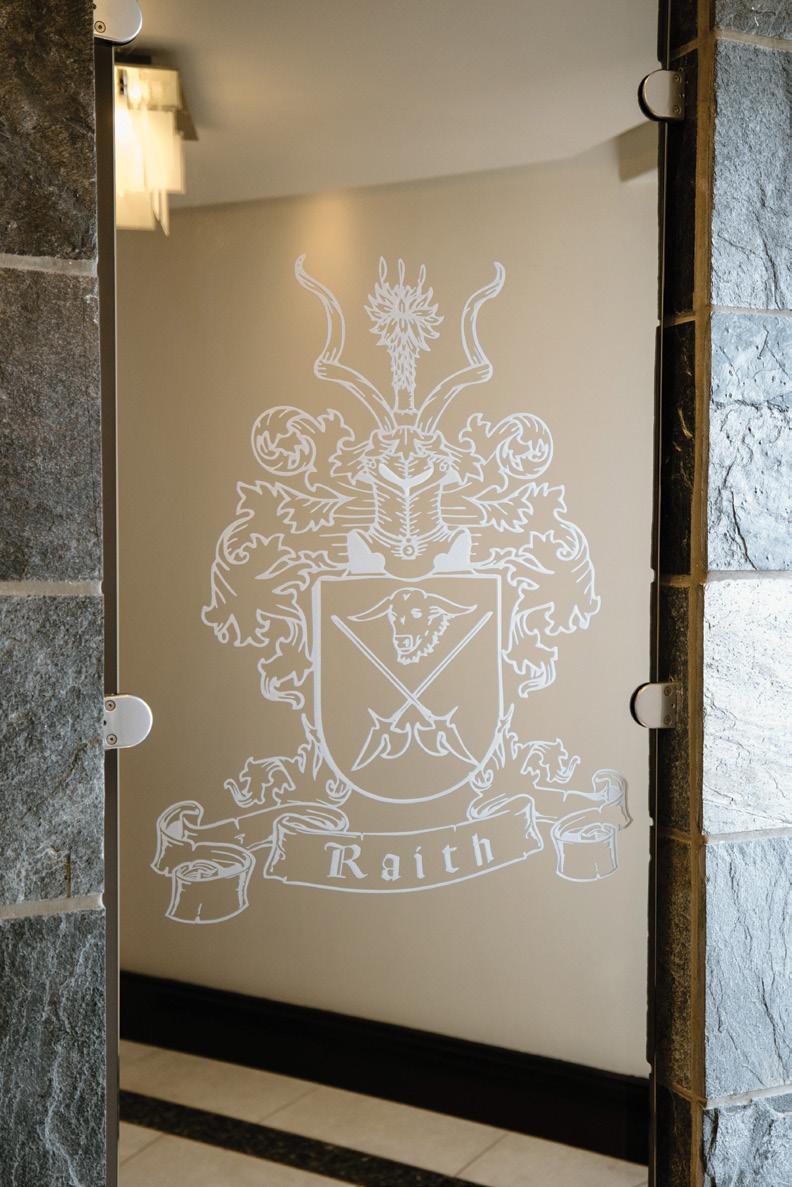

By Kirsty Watermeyer

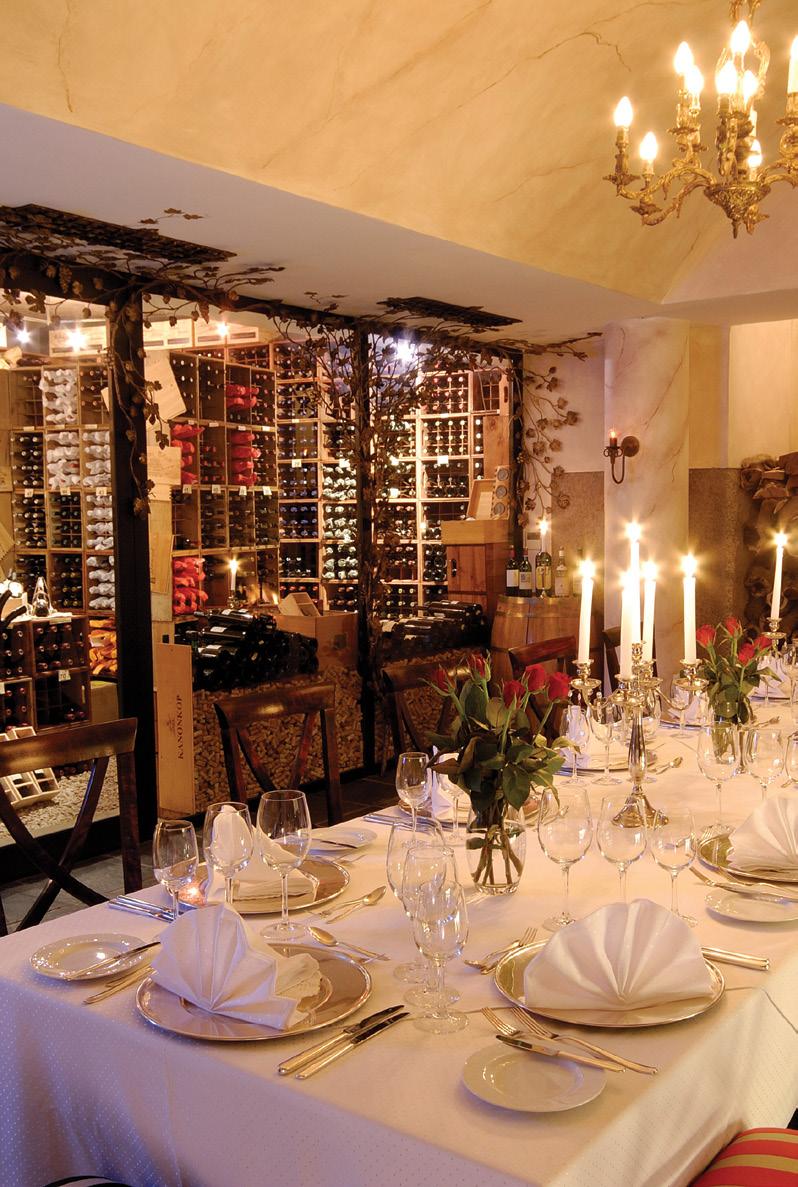

That is what the story of Heinitzburg Castle is all about – the enduring love of one man for one woman in the 19th century, and the love of one woman for a 110-year-old castle in the 21st century. It is also a story of family, dedication and history. This is the essence of Hotel Heinitzburg.
What strikes me most as I sit down with Beate Raith, the owner of Hotel Heinitzburg, is the depth of her love and passion for this place. It is not just a hotel, but a living, breathing legacy. Her connection to the castle is evident in her every word. She lovingly refers to it as "the 110-year-old lady," and with each passing year, she pours more of herself into it. "Some days she needs more love than others, more makeup," Beate laughs, as she reflects on the care the castle requires.
The history of Heinitzburg is as rich and romantic as its owner’s affection for it. Commissioned by Count von Schwerin in 1914, the castle was built in honour of his beloved fiancée, Margarete von Heynitz. Originally named "Heynitzburg," Count von Schwerin had this castle built a short distance from his own, as although betrothed, he and Margarete lived in separate castles during their engagement. There is an enduring legend that a secret underground tunnel connected the two estates, allowing the two lovers to secretly visit one another.
Beate smiles when she mentions the trapdoor in her castle that leads to this hidden passageway. Though she has never explored it in the 30 years she’s owned the property, she holds a deep respect for the castle’s secrets and its history, and even its romantic folklore. “The castle must keep some of its mysteries,” she says with a twinkle in her eye.
In 1994, Beate and her late husband Juergen Raith catered a monumental event marking the return of Walvis Bay to Namibia – a historic celebration attended by eight heads of state and over 1,500 guests. The earnings from this event would lay the foundation for their purchase of Heinitzburg Castle. At the time, they never dreamed of owning a castle. It wasn’t until they heard that it was for sale that Beate’s curiosity led her to visit.
When the couple first visited Heinitzburg, the castle was in a state of disrepair – there was no running water, and the property looked more like a ruin than a residence. But despite its condition, the stunning view from the terrace, especially in the evening, captivated Mrs Raith. As she looked out over the vast landscape, a thought crossed her mind: We could make something of this. This could be our next adventure.
To a young woman whose passion for the hospitality world was only matched by her attention to detail, it was a diamond waiting to be polished. With her husband Juergen, a legendary chef, by her side and driven by unwavering determination and vision, she began to restore Heinitzburg to its former glory.
In 1994 the couple took the first steps toward transforming the castle into what would become a boutique hotel. Beate remembers those early days fondly, the excitement of serving breakfast to a single visitor. Beate recalls how proud she was to host her first dinner for ten people in the castle.
By 1999, the castle had seen its first major renovation: 10 new rooms were added, a wine cellar was built, and a restaurant was constructed. Today there are 16 spacious rooms, where no two are alike. Beate has worked to ensure that the castle maintains its character while offering the modern comforts of a luxury hotel, blending the past and present in a way that honours both.
The historical charm of the castle is still seen today in things like its original wooden panelling or flooring. The original wood carvings by Aschenborn remain on display throughout the castle, depicting figures like Diana, the goddess of hunting, and Pan, the god of the wild. There are also intricate "ancestor trees" carved into the wood, which are linked to local legend. “I’m told that the Herrero people believe that out of one of these trees, Adam fell, and from the other, Eve,” Mrs Raith shares. Each of these pieces is a living artefact, telling a story not just of the castle but of the people who lived and loved within it.
Throughout all the changes and additions over the years, Heinitzburg Castle has maintained its unique charm. It’s a place where the past and present blend seamlessly, where history and personal passion create an environment that feels both timeless and intimate. Beate shares that it hasn’t always been easy in her 30 years at the castle, “but it’s been worth it. Every day is a new challenge, a new opportunity. I can’t imagine doing anything else. I would start all over again if I had to.”



Experience the ultimate in luxury with Westair’s Private Charter flightsseamlessly taking you to any destination in Namibia and beyond.






Today, Heinitzburg Castle continues to thrive, and the stories of its past remain integral to the experience. The owner reflects, “The castle is 110 years old, and like any old lady, she needs attention. But I have so much love for her. I want her to last another 110 years.”
Despite being a family-run business, the hotel’s success is not just about her and Juergen. The couple built a team that would become as much a part of the family as any relative. Some of her employees have been with her for 30 years. Their loyalty is a testament to the kind of place Hotel Heinitzburg became.
When the internationally acclaimed and highly respected chef Juergen Raith passed away, their son Tibor stepped up to continue his legacy. “After Juergen passed, it was incredibly hard, but my son Tibor took charge. A professional chef, he raised the culinary standards even higher. Having trained in Europe, he returned to work alongside me, infusing Heinitzburg with the finest European techniques. Today, he ensures the kitchen remains one of the best in the country.”
What’s more, the legend of the castle continues in families. The original owners of the castle, Margarete and Count von Schwerin, had three sons before they left the castle and moved to Swakopmund. The second owners of Heinitzburg, the Levinson family, also had three sons. Olga Levinson, in particular, was celebrated within the art community, and her contributions can still be seen in the castle today. The third owners, the Raith family, continued the tradition with three sons of their own.
Heinitzburg Castle is renowned for its exceptional wine collection, a passion that dates back to the early days of its restoration. When the restaurant was built, so was the wine cellar – a labour of love. Stored in perfect conditions, the cellar houses some of the castle’s most prized bottles, many dating back decades. “We have incredible wines, some from estates we've worked with for years. It’s like a big family, and I love sharing that with my guests,” says the owner.
Over time, the collection has grown to include over 12,000 bottles, featuring rare and fine vintages from South Africa and beyond. This passion has led the owner to launch Bacchus Wine and Spirits, a new venture that allows her to source wines directly from estates and share her love for wine with even more people. “Wine is my hobby, but I take it very seriously – I know my wine.”

Heinitzburg Castle isn't just a place to stay – it's a living, breathing story that evolves with each passing year. Beyond the captivating architecture and luxurious accommodations, it’s the history, the personal touches, and the tales that make it come alive for every guest who walks through its doors. Hotel Heinitzburg is a place where history, love, and hospitality meet. A place that continues to welcome all with open arms and a warm heart.
With 30 years at the helm, the castle may be known as the 'old lady,' but it is Beate – equally a 'lady' in her own right – who is at the heart of the story. A passionate and savvy businesswoman, Beate has expanded her hospitality group to include the well-regarded Oyster Box in Walvis Bay, a charming bed and breakfast in an ideal location on the Walvis Bay Lagoon. Despite her success, she remains humble. “I don’t lean back and say, I’ve made it,” she admits. “Every day is a new day. I strive to learn, to improve, and to offer something special. The secret is passion. You have to do it with passion.” TN
To book at Leo's at the Castle at Hotel Heinitzburg, call +264 61 249 597 or email heinitzburg@heinitzburg.com The brightest Jewel in the Land of Gems






Keep an eye on our website for updates: www.travelnewsnamibia.com
As Namibia continues to establish itself as a leading travel destination, the Ministry of Home Affairs, Immigration, Safety, and Security (MHAISS) is set to implement new visa regulations aimed at streamlining travel and enhancing the visitor experience. These regulations will come into effect on 1 April 2025, introducing several key changes to make travel more convenient and accessible.
From 2025, travellers will be able to use an online application form for the visa-on-arrival process. This pre-arrival option is designed to simplify procedures and is linked to Interpol for security checks, ensuring fast and secure processing at major points of entry.
2.
The new visa-on-arrival policy will officially take effect on 1 April 2025. The cost for the visa is NAD 1,600, with the ministry confirming that this fee applies to all eligible travellers.
3.
To support cross-border travel and encourage regional tourism, Namibia will introduce multiple-entry visas. This change is expected to benefit tour operators and travellers planning itineraries that span multiple countries, fostering greater collaboration with neighbouring destinations.
4.
In a move to further simplify processes, the departure forms previously required for exiting Namibia will be discontinued. This change will ease the exit process for all visitors, ensuring a smoother conclusion to their Namibian journey.
5. VISA-ON-ARRIVAL AVAILABILITY
The visa-on-arrival service will be available at major border posts, which will also be equipped with swiping facilities for convenient payment. However, smaller border posts may not yet have these facilities. A full list of participating border posts will be released to ensure clarity for travellers and operators.
6. MARKETING TOOLKIT FOR THE TOURISM INDUSTRY
In collaboration with the Namibia Investment Promotion and Development Board (NIPDB), the ministry is preparing a marketing toolkit and updated resources to assist the tourism sector in promoting the new visa regulations. These materials will be shared with industry stakeholders to ensure clear and consistent communication.
7. HOW TO APPLY
Visitors can apply for visas:
• Online before arriving in Namibia, reducing time spent at immigration counters via https://eservices.mhaiss.gov.na
• At Namibian embassies or consulates
• On arrival at Namibian ports of entry TN


















